 4th Edition College of Arts & Media Magazine, Fall 2022
4th Edition College of Arts & Media Magazine, Fall 2022
4th Edition College of Arts & Media Magazine, Fall 2022
Dr. Ronald E. Shields, Dean College of Arts & Media
THE CREATIVE TEAM
Editor
Weslie Gray
Contributing Writers & Editors
Julia May
Jackie Swan
Nifemi Bola
Lisa Sevilla
Layout & Design
Ashley Defrancis
Amanda Saucedo
Parker Marley
Kira Wygle
Photography
Angi Sosa
Kazai Drew
Ashley Defrancis
Videography
Steven Romero Jr.
CAM SOCIAL
Follow us on social media to stay up-to-date with what’s happening at CAM!
For questions or concerns, contact us at marketing@shsu.edu @shsucam @shsu_cam @shsucam
SHSU College of Arts & Media
Board of Regents The Texas State University System
Brian McCall, Chancellor, Austin
Duke Austin, Chairman, Houston
Garry Crain, First Vice Chairman, San Marcos
Alan L. Tinsley, Second Vice Chairman, Madisonville
Charlie Amato, Regent, San Antonio
Sheila Faske, Regent, Rose City
Dionicio (Don) Flores, Regent, El Paso
Nicki Harle, Regent, Baird
Stephen Lee, Regent, Beaumont
William F. Scott, Regent, Nederland
Gabriel Webb, Student Regent, The Hills
ON THE COVER
New year, new uniforms — the Bearkat Marching Band proudly takes the field this fall sporting brand new uniforms alongside the Bearkat football team (2020–2021 NCAA Division I National Champions). See them live on the field during halftime by visiting gobearkats.com
Throughout this magazine, you will find interactive content. We invite you to explore and engage to learn more about our stories.
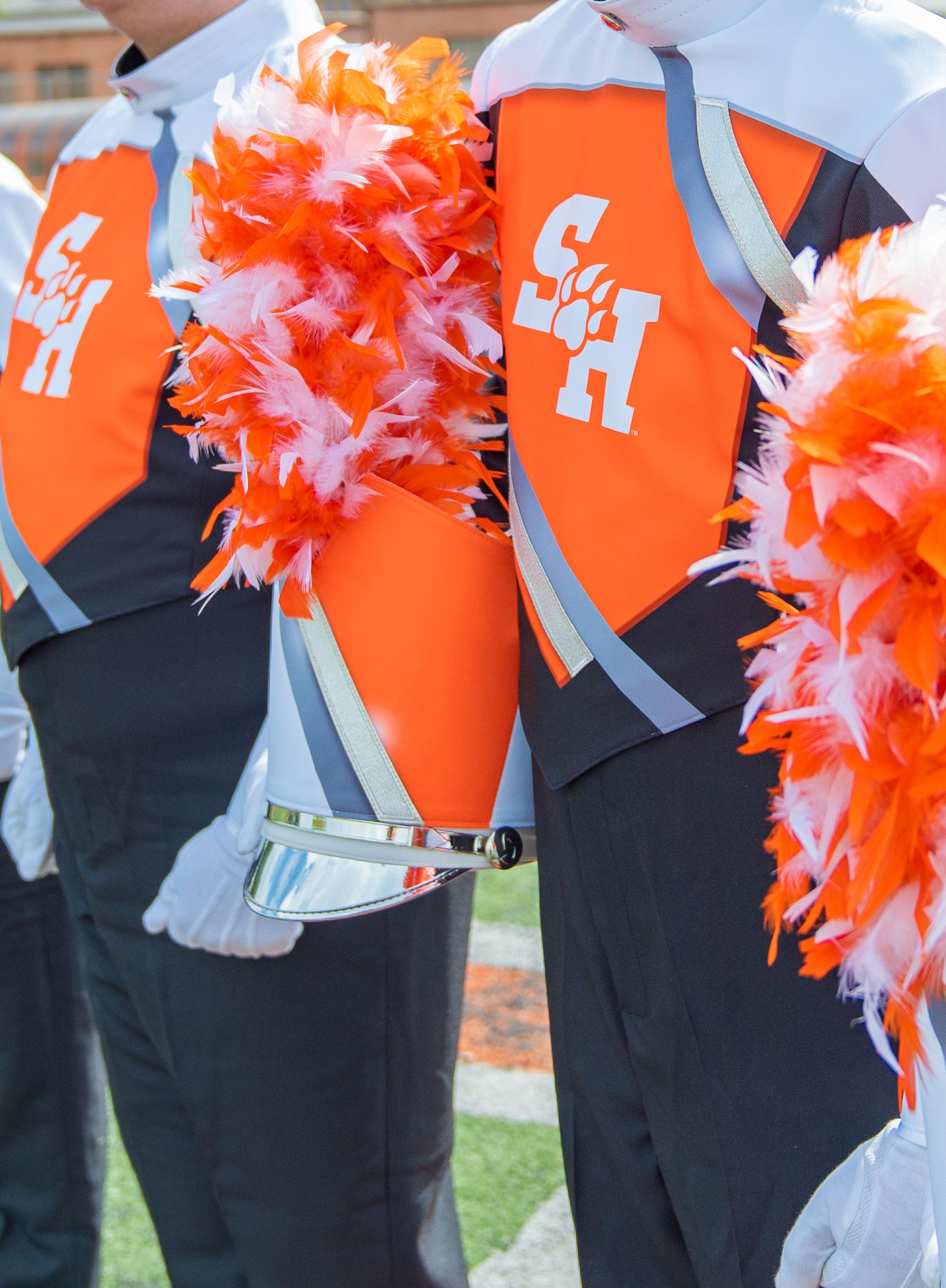



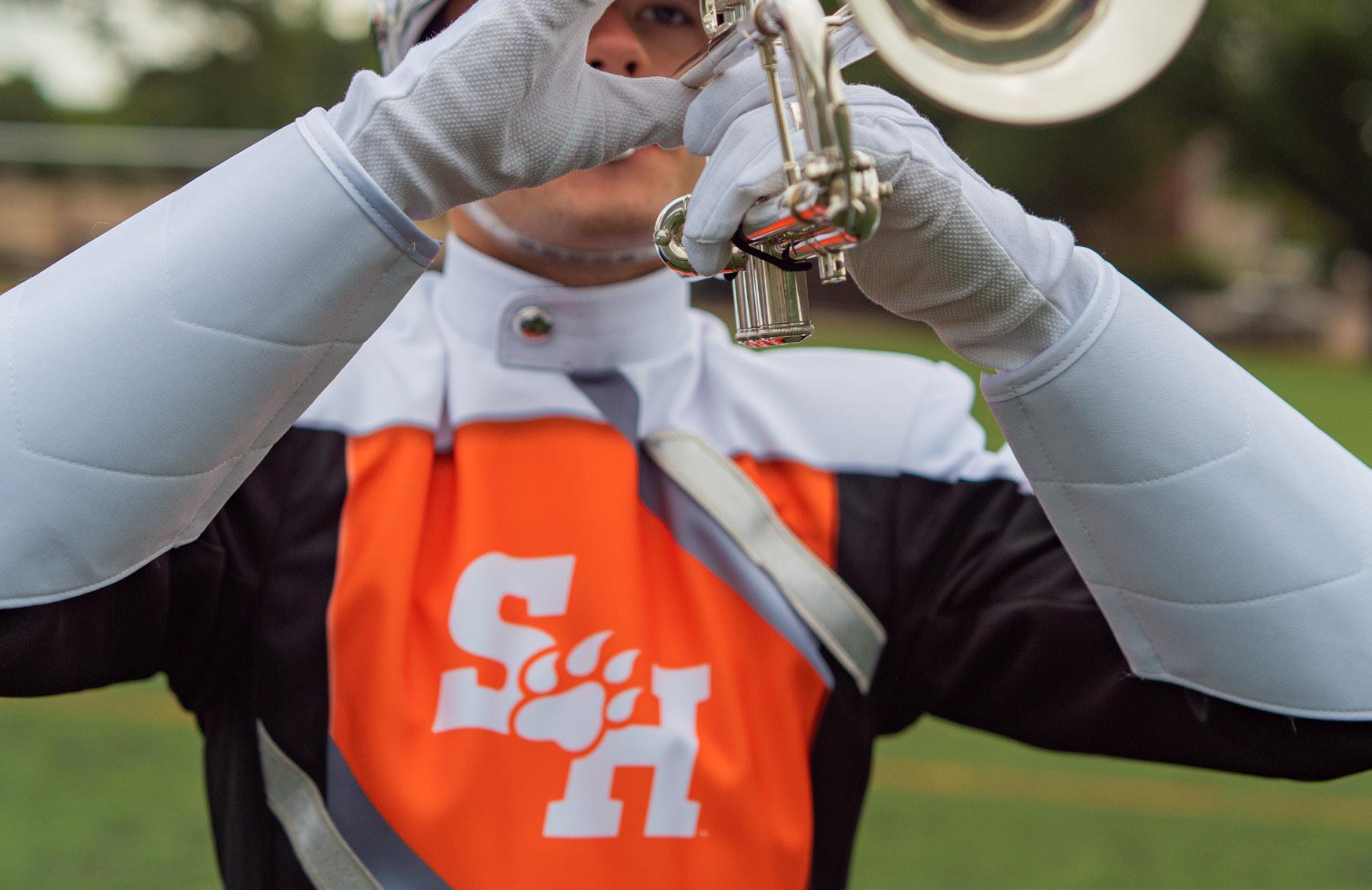

03 15 23 31 39 49 61 2 | CAM Magazine, Fall 2022 The
Letter of
from the Dean School of Music Choreography & Collaboration Behind the Scenes... What Does It Take?
Department of Art Department of Theatre & Musical Theatre 17 25 51
Department of Dance CAM Donors 33 41
Department of Mass Communication
Art
Camaraderie
Joint Efforts in Journalism Halftime Harmony
COLLABORATIVE EXCELLENCE
A LETTER FROM THE DEAN

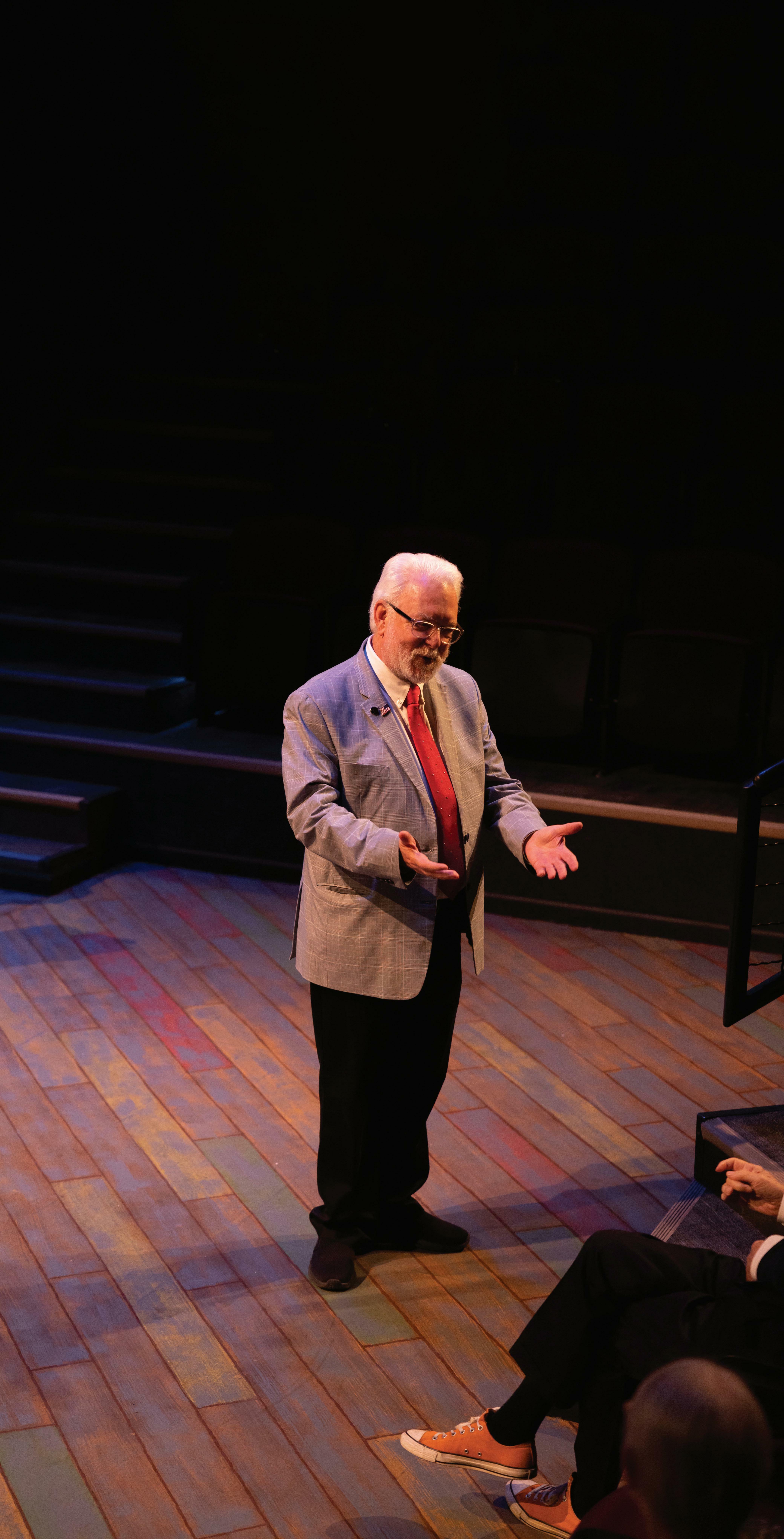
Early meanings of the word “team” speak to new life and abundance. Other meanings followed such as binding animals into work teams, or in our contemporary sense, individuals willingly working together for a common good or goal. This issue of CAM Magazine, our fourth, illustrates why the College of Arts & Media can best be
described as creative, active, and meaningful through individual accomplishments and effective teams.
In this issue, we celebrate our students who do the individual work behind the scenes and in the practice studios to prepare themselves to contribute and learn as cast member, crew member, and/or ensemble member. These individuals create these CAM teams. You can’t have an opera or play, a world premiere musical theatre production, an outstanding CAM marketing and communications internship program, distinctive and student-focused dance concerts, or our Bearkat Marching Band without talented, dedicated, and prepared teams of theatre artists and dancers, musicians, community engaged artists, and graphic design and media specialists.
The contents of this issue of our CAM Magazine strive to provide context and an overall sense of the vibrancy of our programs as well as the talents and dedication of our students, faculty, and staff. We continue to offer an interactive publication that invites you to scan the QR code to hear the voices and see the faces of our CAM community. I urge you to take the time to do so.
Thank you for your continued support of the College of Arts & Media at Sam Houston State University.
My best,

3 | CAM Magazine, Fall 2022
ACTIVE MEANINGFUL
CREATIVE
Dr. Ronald E. Shields, Dean College of Arts & Media
COLLEGE OF ARTS & MEDIA
CREA TIVI TY Imagination in action.
VISION
together to advance ar ts
media for the
of our
Learning
&
benefit
communities.
#SHSUCAM #CAMArtistSeries



The
reimagined
and the
#SHSUArt #GraphicDesign "Transcend” exhibited the works of our 2022 graphic design senior class. @shsucam @shsu_cam @shsucam SHSU College of Arts & Media 5 | CAM Magazine, Fall 2022
& MEDIA NEWSFEED
Texas Guitar Quartet brought a fiery energy as part of the 2021–2022 CAM Artist Series. School of Music faculty member Alejandro Montiel was excited to introduce a mix of
classics
world premiere contemporary works with his quartet.
COLLEGE OF ARTS
#SHSUDance #SeniorStudio
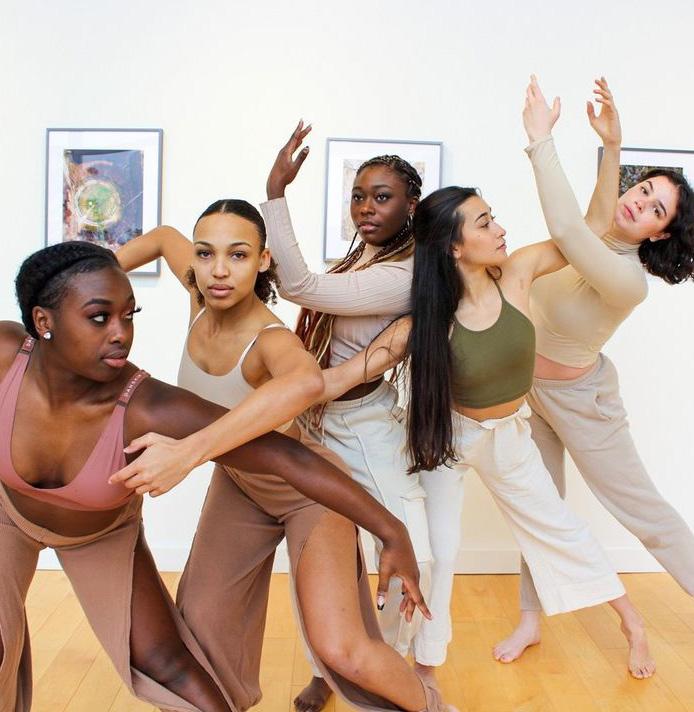
“Emergence”
#SHSUMassComm #Channel7

It’s

#SHSUMusic #JazzFestival

#SHSUTheatre #FallMusical
Adapted
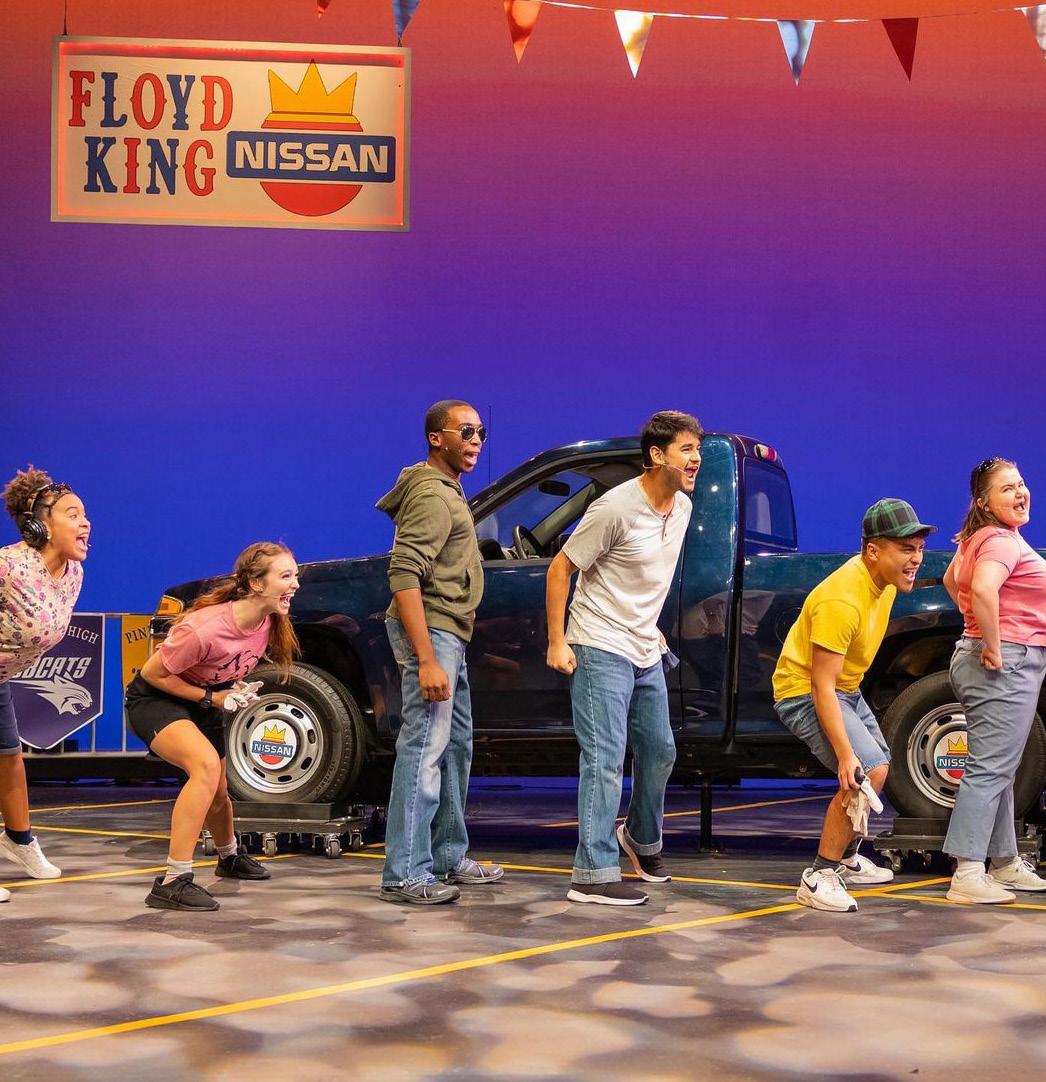 submerged the audience into diverse creations ranging from cultural dance works to picturesque storytelling, to going against societal normality through works created by 15 dance artists of our 2022 senior class.
The Bill Watrous Jazz Festival made its comeback in April and included an exciting reunion performance by the 1978 SHSU “Catabiando!” Jazz Ensemble conducted by David Caffey. ��
always a bittersweet day in the studio when our student crews wrap up their last newscast of the semester.
from a 1997 documentary by S.R. Bindler, “Hands on a Hardbody” shared the story of a hard-pressed bunch of Texans hoping to beat the odds and win a truck in a grueling contest, fighting to hold onto hope in the face of fierce economic headwinds and bad breaks.
written by Jackie Swan
submerged the audience into diverse creations ranging from cultural dance works to picturesque storytelling, to going against societal normality through works created by 15 dance artists of our 2022 senior class.
The Bill Watrous Jazz Festival made its comeback in April and included an exciting reunion performance by the 1978 SHSU “Catabiando!” Jazz Ensemble conducted by David Caffey. ��
always a bittersweet day in the studio when our student crews wrap up their last newscast of the semester.
from a 1997 documentary by S.R. Bindler, “Hands on a Hardbody” shared the story of a hard-pressed bunch of Texans hoping to beat the odds and win a truck in a grueling contest, fighting to hold onto hope in the face of fierce economic headwinds and bad breaks.
written by Jackie Swan
The Sam Houston State University College of Arts & Media presented an opera performance of Pauline Viardot’s “Cendrillon,” a charming retelling of the beloved Cinderella story, which ran Nov. 18–20, 2021 in the Erica Starr Theatre on the Huntsville, TX campus.

In a truly creative collaborative effort, three areas within the College of Arts & Media – music, dance, and theatre and musical theatre worked together to create this fully staged opera thanks to support from Ronald E. Shields, dean of the college, and Scott Plugge, director of the School of Music.
Sung in French with English supertitles and directed by associate professor Rebecca Renfro, “Cendrillon A Cinderella Story” featured dialogue in three acts with a story following closely to the original timeless tale written by Charles Perrault with a few variations.

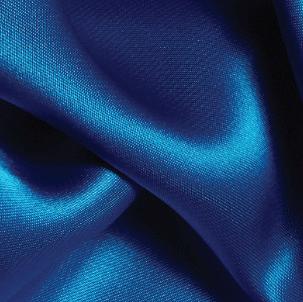
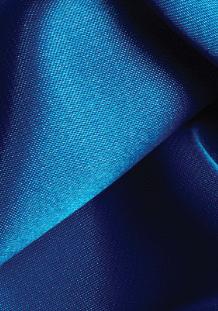




The performance also occurred in the 200th birth year of Viardot, serving as a celebration of her memory and formidable talent. Between the extravagant ballgowns designed in-house by dance staff member Barry Doss and the magic created through production teamwork, the CAM rendition of “Cendrillon” was nothing less than a dream come true.
Opera students Rina See and Jimmy Paz starred as Cendrillon and Prince Charming, along with fellow students Annelise Diaz, Lucianna Astorga, Amanda Ronquillo, Piero Regis, Chandler Peveto and Diana Villa. The production also featured SHSU vocal performance alumnus and Houston Grand Opera member Heath Martin in the role of Baron de Pictordu, as well as guest conductor and former National Opera Association president Benjamin Brecher, who led an accompanying orchestra of SHSU faculty and students.

7 | CAM Magazine, Fall 2022


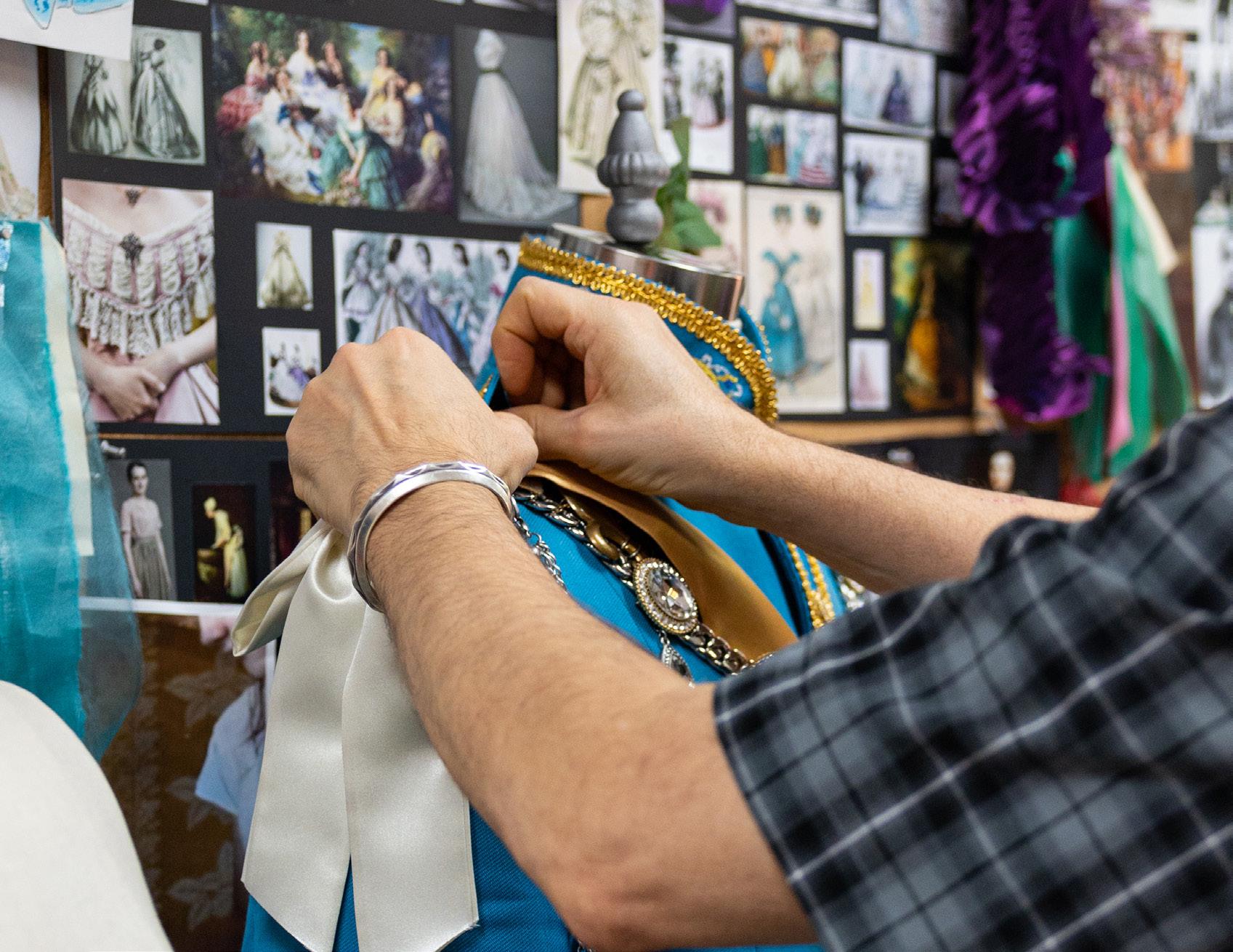
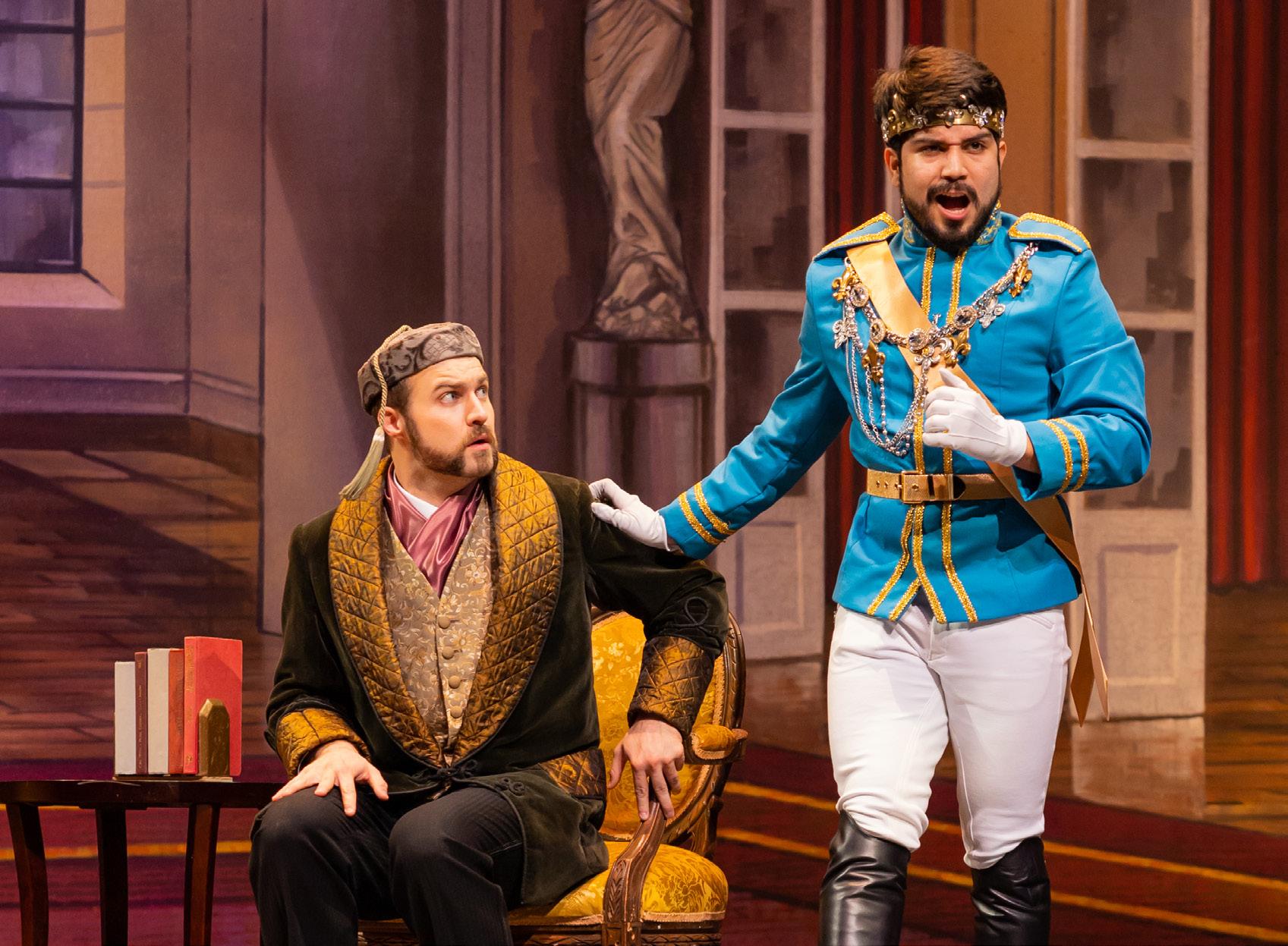
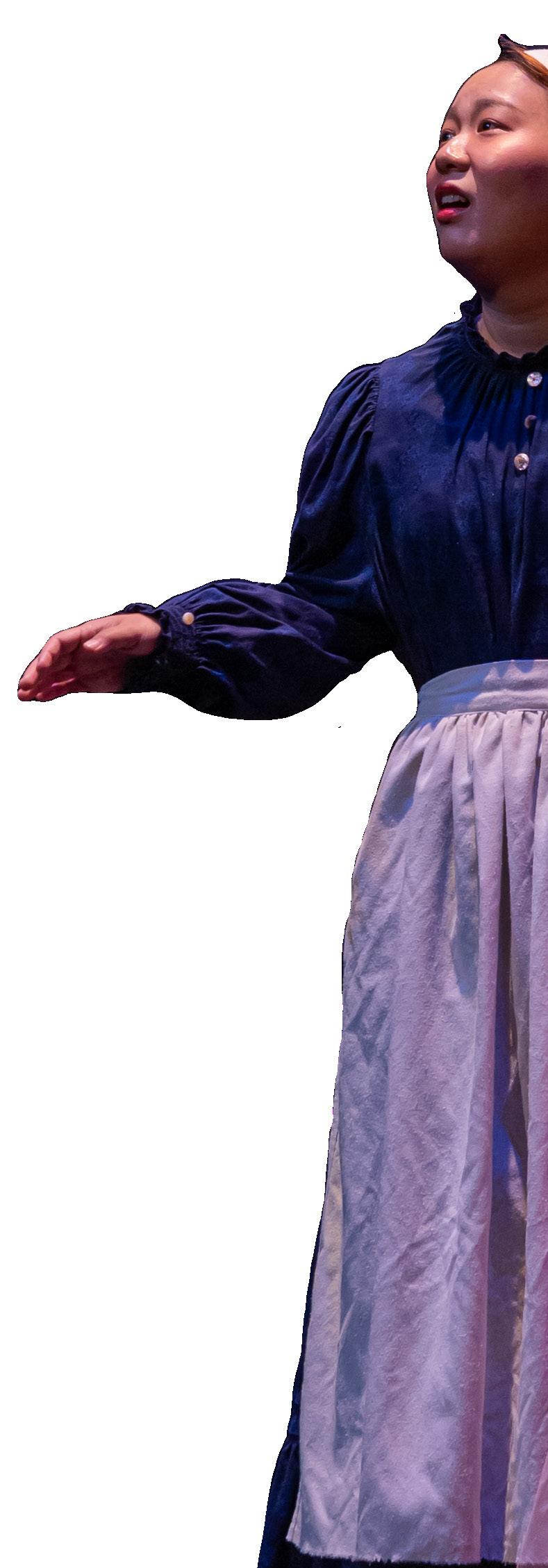
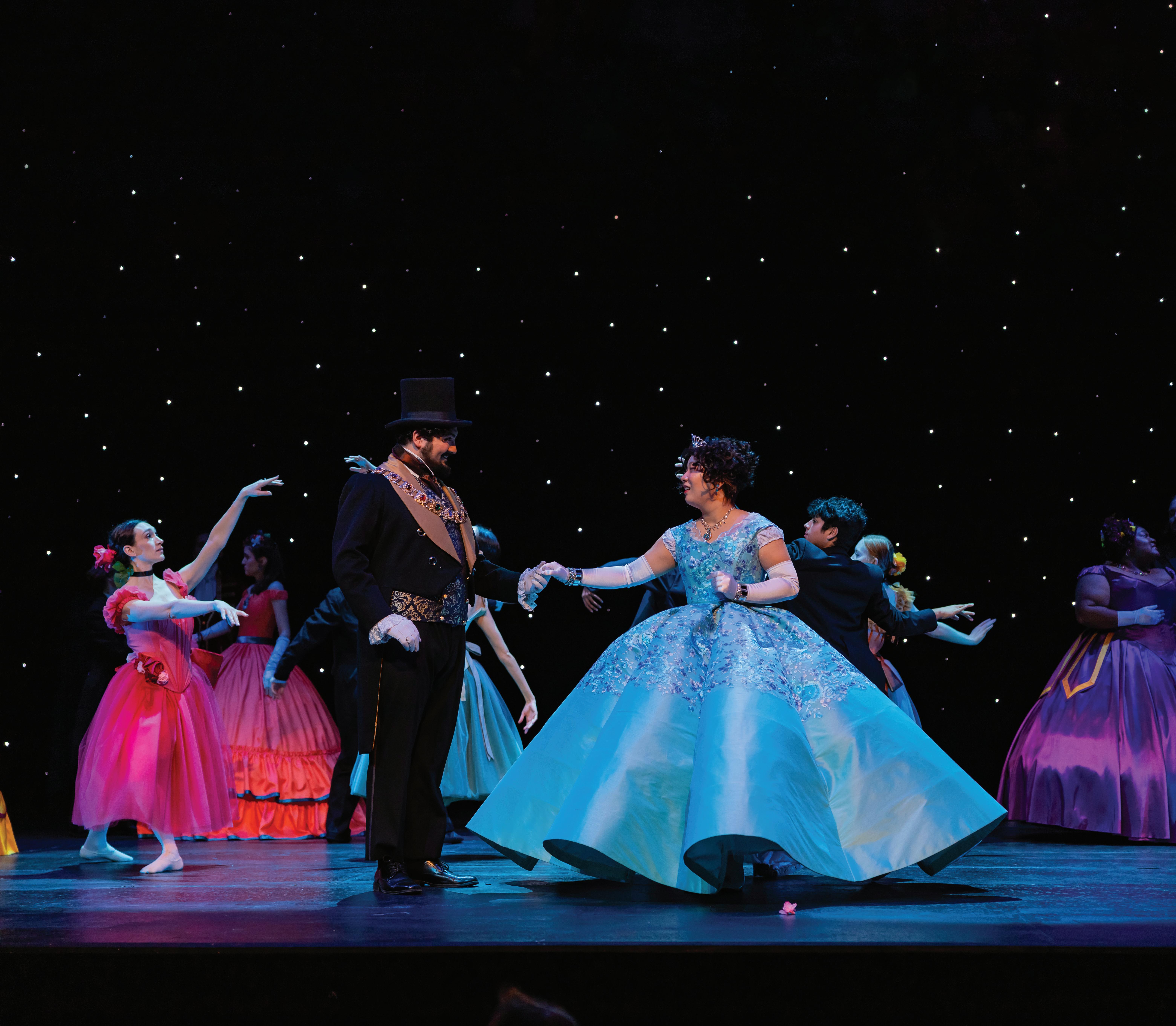
9 | CAM Magazine, Fall 2022
The departments worked together on this project with a shared joy and mutual admiration for one another’s talent and craft
THIS IS THE ULTIMATE AIM OF ARTISTIC EXPRESSION
 — Rebecca Renfro
— Rebecca Renfro
IN HIS OWN WORDS
A Visit With Peter Roussel About His New Musical
written by Julia May
Since 2009, former White House spokesman Peter Roussel has been the Philip G. Warner Endowed Chair in the Department of Mass Communication at Sam Houston State University. In that role he has taught courses on public relations and presspresidency interactions.
Under his guidance, the student public relations firm Priority One was created, representing both on and off campus clients in much the same way as a professional public relations firm. He also led the effort that resulted in publication of the book, “The Story of the Sam Houston Chickens.” He is currently writing his memoir.
His honors at the university include two Sammy Awards as Outstanding Student Organization Advisor, two Keys of Excellence Awards presented by the university’s Orange Key Organization, and the Legacy Award presented by the College of Arts & Media which recognizes individuals who, through distinctive professional accomplishments, personal integrity, and service have built a legacy for SHSU students.
His distinguished career includes having served as special assistant and deputy press secretary to President Ronald Reagan, 1981–87. His first tour of duty in the White House was as staff assistant to President Gerald R. Ford, 1974–76. From 1969–74, he was press secretary to President George H. W. Bush. Roussel has also been a public relations executive, broadcast commentator, and is currently a playwright and author. After publication of his novel “Ruffled Flourishes” in 2009, he adapted it as a play that received three world premiere performances in 2016 at SHSU.
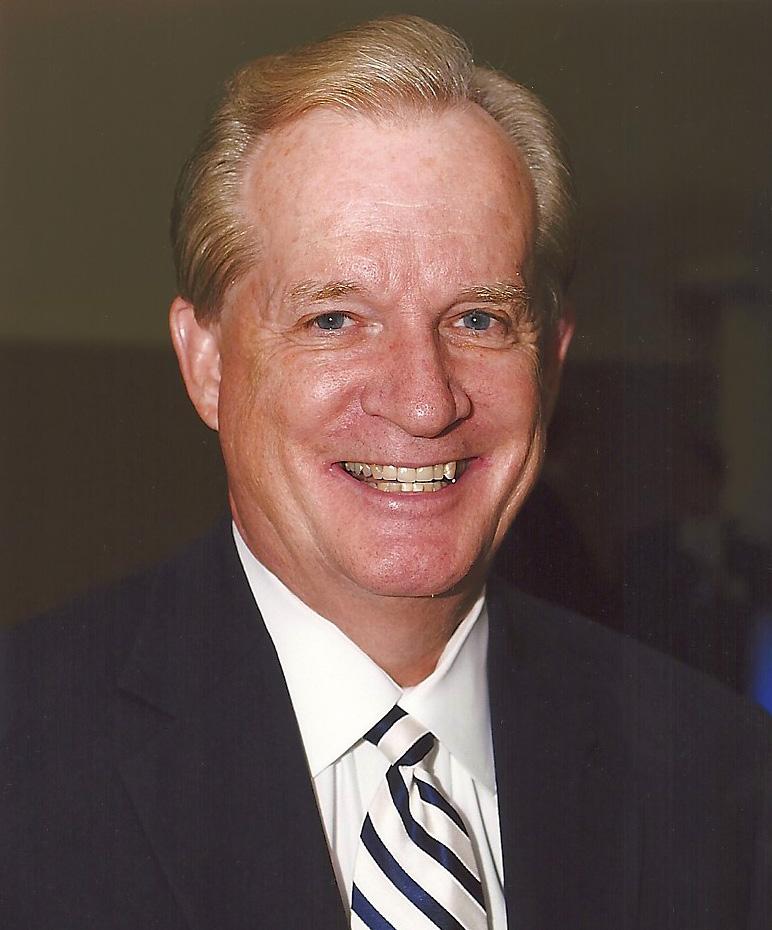
Most recently, he has adapted the play as a musical, working as a team with Kyle Kindred, SHSU professor of theory and music composition. Following a well-received workshop performance on campus in June 2022, the next anticipated stop for the musical is a full scale theatrical premiere production.
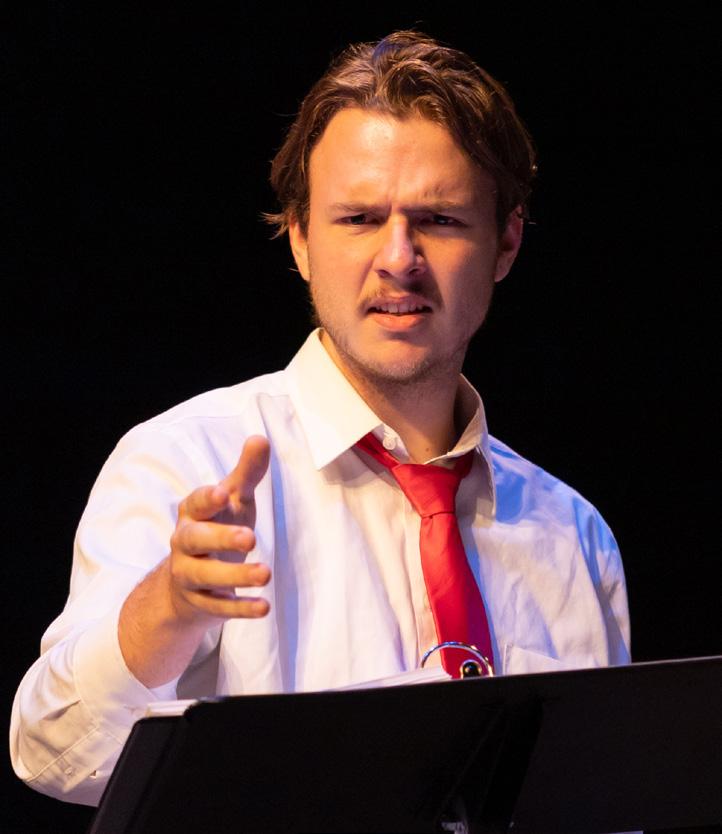
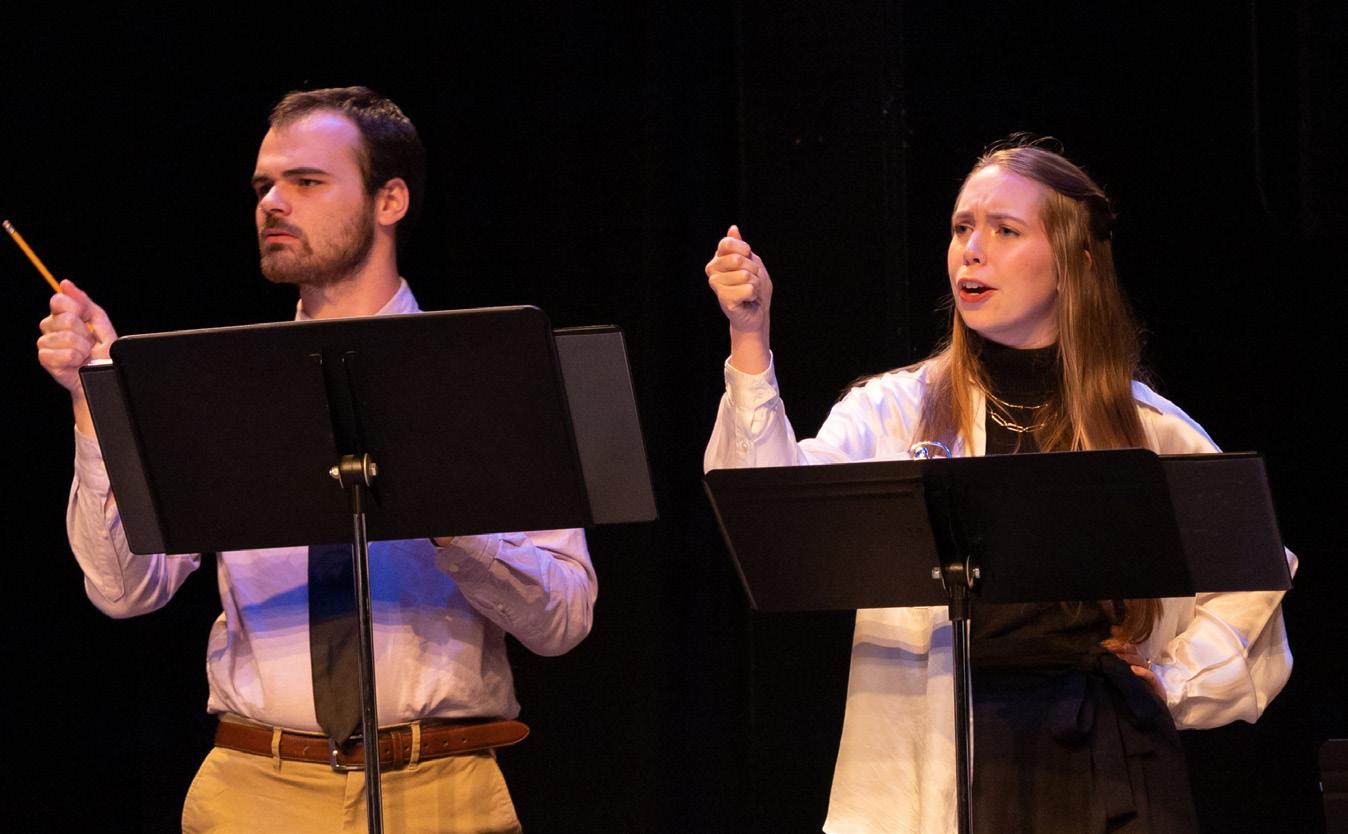

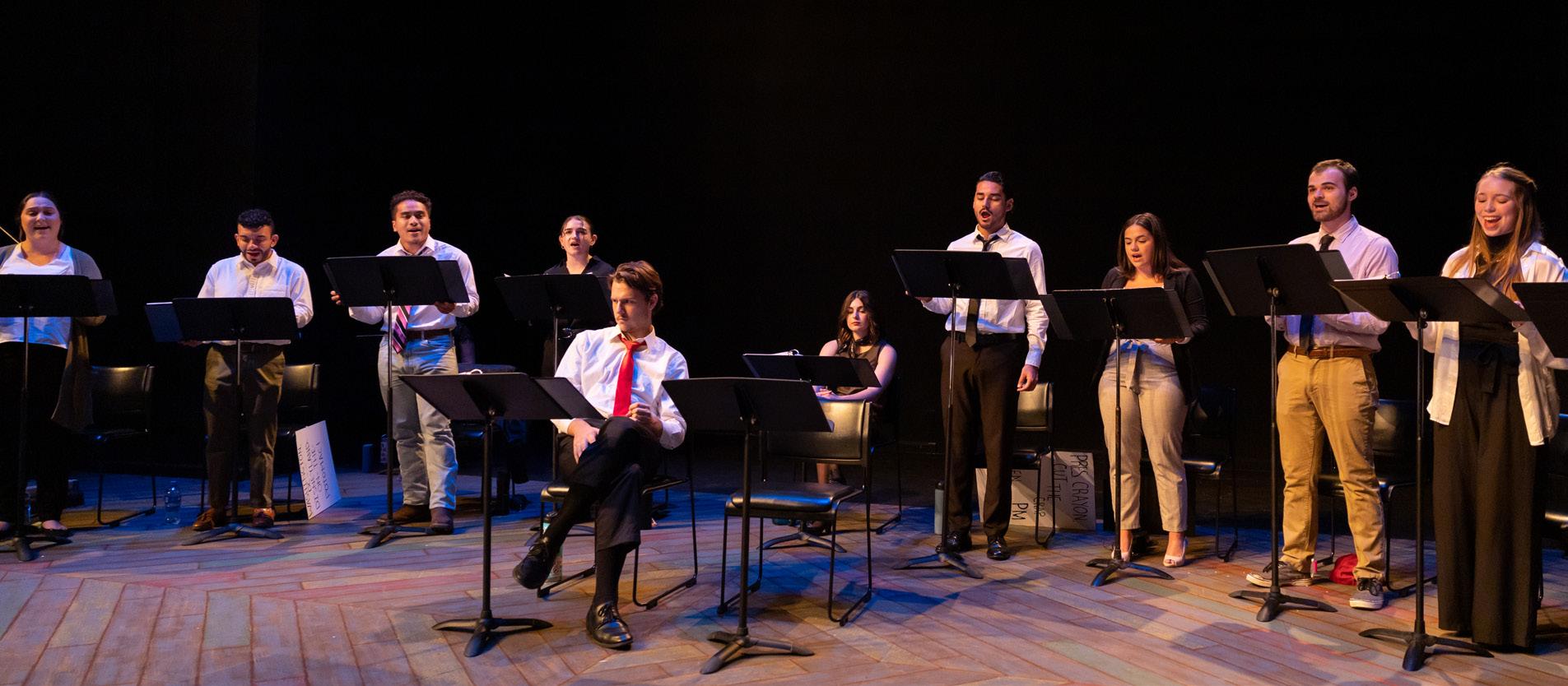
While preparing for the workshop production, Roussel sat down with Julia May to give his thoughts on his latest creative venture.
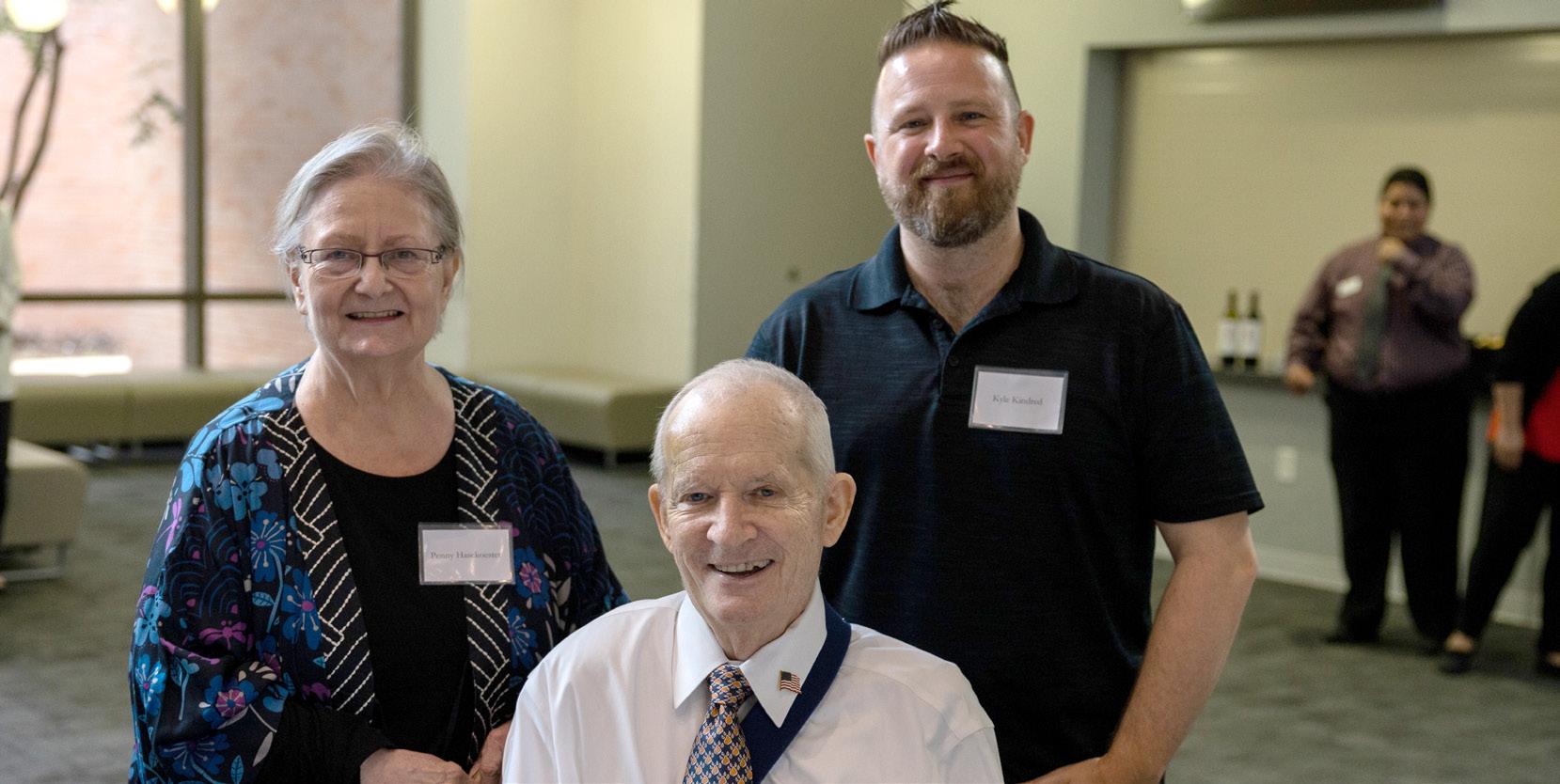
11 | CAM Magazine, Fall 2022
May: How did the novel evolve into a play, which has now evolved into a musical?
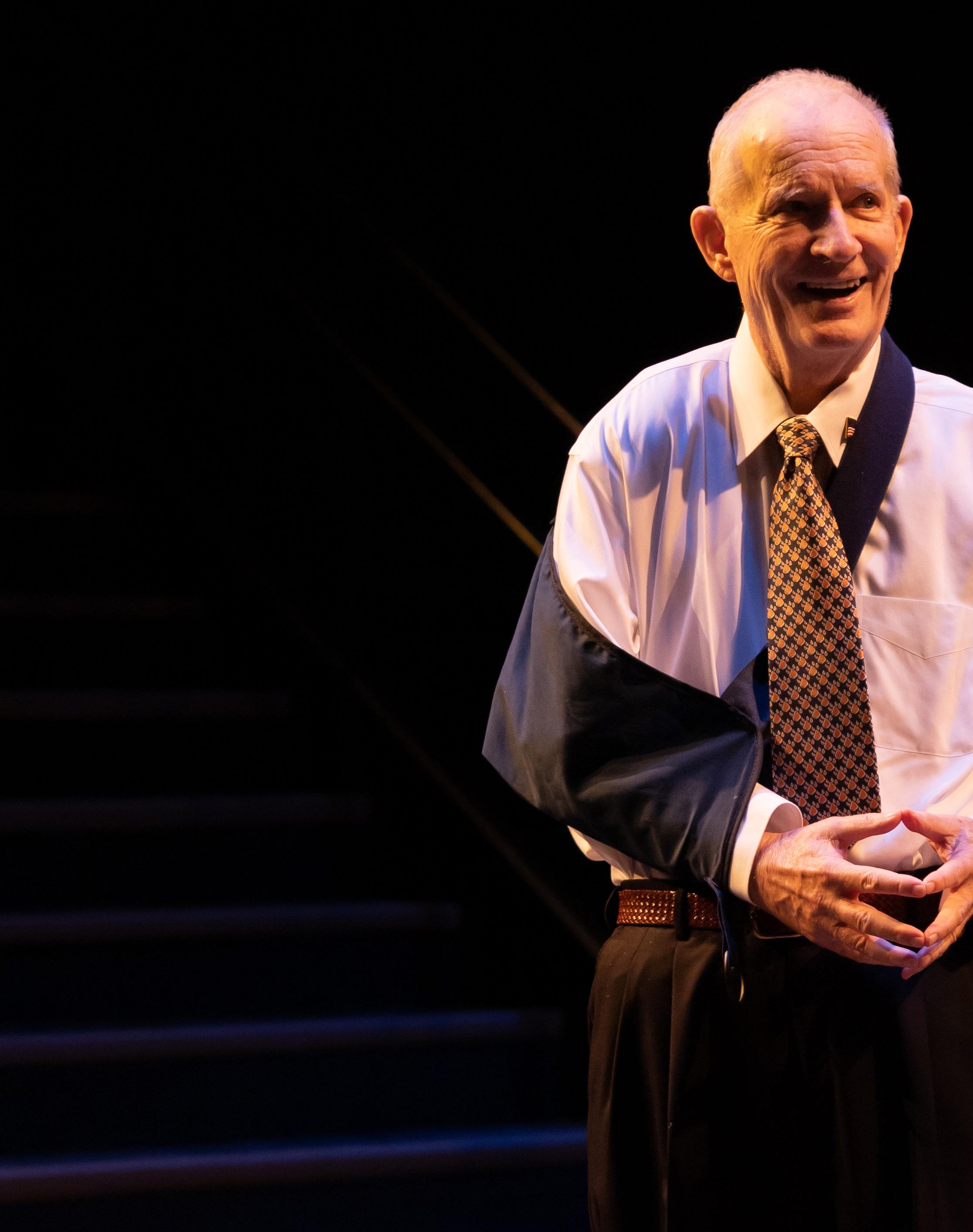
Roussel: The novel was published in 2009. Although it is fiction, I drew on my firsthand experiences as a spokesperson for two presidents of the United States. Since I come from a theatre family (my father was a drama/music/film critic for the Houston Post, 1933–66; and my mother was an actress and one of the founders of the Houston Little Theatre), I began thinking about the novel for its theatrical possibilities, both dramatic and comedic. After all, much of it takes place in the White House press briefing room, which I found to be a theatre of both drama and humor. The play version was produced in 2016 at Sam Houston State University for three world premiere performances. Based on the positive reviews it received, producing it as a new and original musical theatre production seemed a next logical step. That proposal received approval from theatre leadership at the university and work began.
May: Kyle Kindred wrote an amazing score for the musical. Did you just give him the script and ask him to write the music and lyrics, or did you have any input into the tone and mood of the songs?
Roussel: Writing a musical is definitely an exercise in collaboration and mutual respect between the author and composer. In my view, these are an absolute necessity if there is to be success. Call it a mutually-shared vision. Kyle Kindred is an outstanding musical talent — creative and dedicated to giving the fullest extent of his abilities to all he creates. In this case, we initially went through the script, and I offered him my suggestions as to scenes for musical placement and what the purpose would be in each instance in terms of advancing and illuminating the story. He would then take this and add his own ideas so that we reached a result with which we agreed and that inspired and moved us onward. He did all this with the creative instincts and dedication of a true professional.
Click here to listen to Kyle Kindred's score for the musical
May: Penelope (Penny) Hasekoester, associate dean and professor of acting and directing in SHSU’s Department of Theatre & Musical Theatre, directed both the play in 2016 and this latest production. What was the selection process for the actors in the musical?
Roussel: The actors were all students in the Department of Theatre & Musical Theatre at Sam Houston State University. They sent in audition tapes and were chosen for their parts by Penny, in consultation with Kyle and myself. This process is akin to that which occurs in the professional theatre. I thought all the actors were outstanding in the various parts they undertook, including some of them playing more than one role.
May: I understand that the presentation of the musical was a workshop performance. Where does the script go from here?
Roussel: A “workshop” is part of the normal process in creating a musical. It is basically an informal presentation where the actors hold the script and music in hand. Its purpose is to determine at that point how well the musical is playing, how an audience is reacting, and any other edits that need to be made before the next step — actual onstage theatrical presentation. I think it’s fair to say that after this workshop performance, the show received a highly enthusiastic audience response. The next step will be the full scale world premiere production of “Ruffled Flourishes: The Musical.”
May: What do you want audiences to take away from the musical?
Roussel: First of all, I hope theatregoers will note that this musical is the result of talent from three departments at Sam Houston State University working together — music, theatre and musical theatre, and mass communication. Secondly, audiences will be provided an insight into the press-presidency process as it existed in the 1980s and the humor that often unexpectedly was part of it. Lastly, the show will provide audiences a look at how demanding is the role of a White House spokesperson, leaving scant time for any other pursuits when one holds that often stressful job. Hopefully, too, audiences will appreciate that we are making American musical theatre history with this show.
Never in history has there ever been a musical on this specific subject — the relationship between the press and the presidency, and especially from a humorous standpoint. I think one would have had to live it in order to write it. I did.
CAM
MARKETING & COMMUNICATIONS TEAM
written by Julia May
Producing high quality messaging and branding materials for the College of Arts & Media, as well the five departments within college (Art, Dance, Mass Communication, Theatre & Musical Theatre, and the School of Music), has been the driving force behind the CAM Marketing & Communications Team.
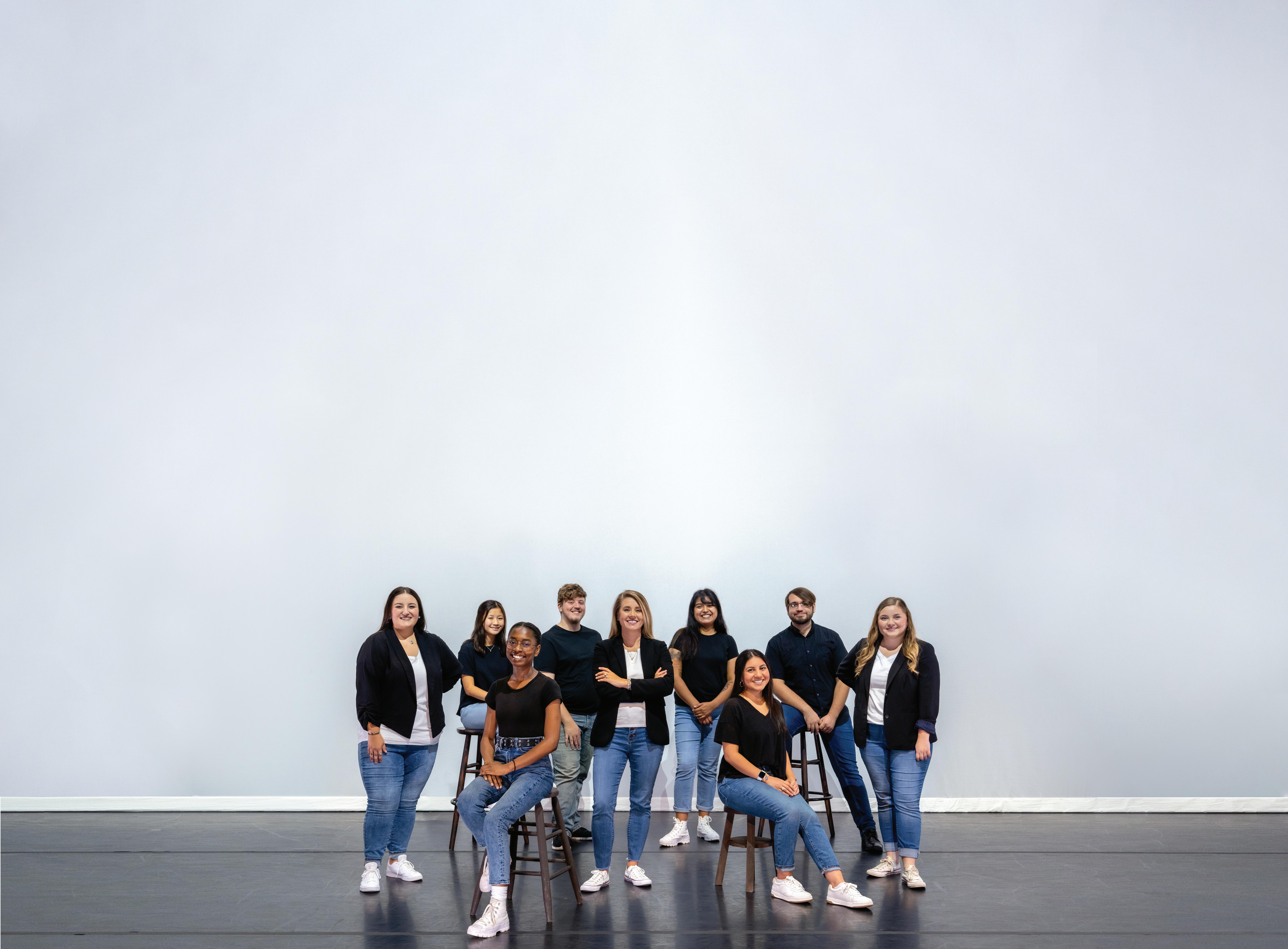
Because of the team’s reputation and success, the college has been invited to join four other colleges at SHSU to participate in an initiative funded by the Texas Department of State Health Services. The $6.1 million grant awarded to SHSU will be used to improve vaccine confidence across all demographics in the state of Texas.
“We were approached by Dr. Chad Hargrave, the university’s associate provost for Research and Sponsored
Programs, to help write a grant proposal for a project that would focus on increasing vaccine confidence across the state, especially within vulnerable and hard-to-reach communities,” said Weslie Gray, director of Strategic Initiatives and Operations for CAM and one of the coprincipal investigators for the research project.
Other SHSU colleges that are involved include the College of Education, College of Humanities & Social Sciences, College of Health Sciences, and College of Osteopathic Medicine. Of the $6.1 million funded, a little more than half will fund CAM’s portion. It’s the largest grant CAM has ever received.
“The first phase of the project involves developing research surveys,” Gray said. “These surveys will be distributed to
the public, as well as clinicians, such as doctors, nurses, and other health professionals. Our team is designing the look and feel of the distribution materials.
“The surveys will give us data on the demographics that align with vaccine hesitancy, which the College of Health Sciences will use to build education modules and prepare content for webinars and public messaging in various forms, such as social media and brief storytelling videos. My team will produce all those materials and determine the best ways to reach people throughout the state,” she said. “It’s challenging, but we have a lot of help from the Office of Research and Sponsored Programs, and it’s a great experience.”
The work on the project is scheduled to be completed by July 31, 2023.
13 | CAM Magazine, Fall 2022
Meanwhile, the team continues to work on daily projects, promoting the college and the departments within the college.
Among those providing their talents are the student interns who are divided into such specializations as graphic design, photography, videography, social media, and copy writing.
“We started small,” Gray said. “I knew that our college had a need for more coordinated marketing across the board. In many ways, because of how much our students do through their public performances, shows, and media products, we are often the face of the university.
“Our marketing and communications efforts have come a long way in a short time,” she said. “We started with one person and a couple of students. Now we have two full-time employees and seven interns. Not only has it improved the image of our college overall, but it has also helped all our majors in general. It increases their visibility and showcases their talent.”
Gray is also proud of how the student interns are getting work experience that they will be able to apply in their careers. The students also get guidance from their supervisors who also acquired their skills when they themselves were SHSU students.
“Ashley Defrancis, our graphic design specialist, and Jackie Swan, our communications coordinator, are wonderful
mentors for our student staff,” she said. “They are both very talented and amazing at taking the students and building them up. As an institution of higher education, we want our students to learn and to succeed.”
“Our student interns play a major role in the success of our college,” Swan said. “Our university wouldn’t exist if we didn’t have students, and this simple fact is what drives me to cultivate the best environment I possibly can for our interns on a daily basis.”
“They all have such a strong passion and take great pride in their work. It’s fascinating to watch them in action, especially when they bounce ideas off each other,” she said. “It really helps to avoid the burnout of one person constantly being responsible for coming up with ideas or recycling the same idea again and again. They truly give everything a fresh perspective.”
Swan is impressed with how the students are willing to voice their opinions and put what they have learned in their classes to use so that the promotion of CAM is topnotch. She also appreciates how the students come from diverse backgrounds, both academically and personally, and are willing to help each other perform difficult tasks.
“Recently, our videographer had to edit and write the subtitles for a six-minute video that was completely in Spanish while being the only intern who did not speak Spanish,” she said. “The other students jumped in without
hesitation to help him translate and get the job done. It’s one of those scenarios that reminds me how proud I am to be an alumna of this college and a part of this team. The atmosphere here is one of cooperation and commitment to do the absolute best job possible. Building our students’ confidence is a top priority for me personally and for us as a team.”
Defrancis works with the student graphic designers and the photo and video interns.
“Not only do we get to mentor our student interns, but we are learning from them at the same time. Every day it’s something new, and it’s very refreshing,” she said. “Before I was employed full-time as the graphic design specialist, I was a graphic design intern in this office. I think it helps my work with the students that I’ve been on both sides.
“Serving as an intern in addition to my coursework was a tremendous opportunity to develop my skills in a professional setting. Each department offers something unique, so there is a wide variety of materials to design and endless creative visions to bring to life. I feel like I learned more as a CAM intern than I would have anywhere else at the time. I grew a lot both personally and professionally.”
Just in a short time, production has increased from a few projects a year to approximately several hundred in the past year.
Today, the CAM Marketing & Communications Team has their own dedicated space in the Dan Rather Communications Building. In addition to providing marketing and communications guidance, oversight, and strategic planning for all academic areas within the college, they manage all official departmental social media accounts, event calendaring, public advertising, and create branded collateral pieces for all college audiences. They also produce the college’s annual magazine, a full color publication which now has an interactive digital companion.
“One reason we’ve been so successful is because we recruit passionate, open-minded students of any major who have the determination to nurture their skillsets,” Gray said. “I’m proud that our team is a major contributor to crafting the next generation of designers, communicators, and media professionals.”

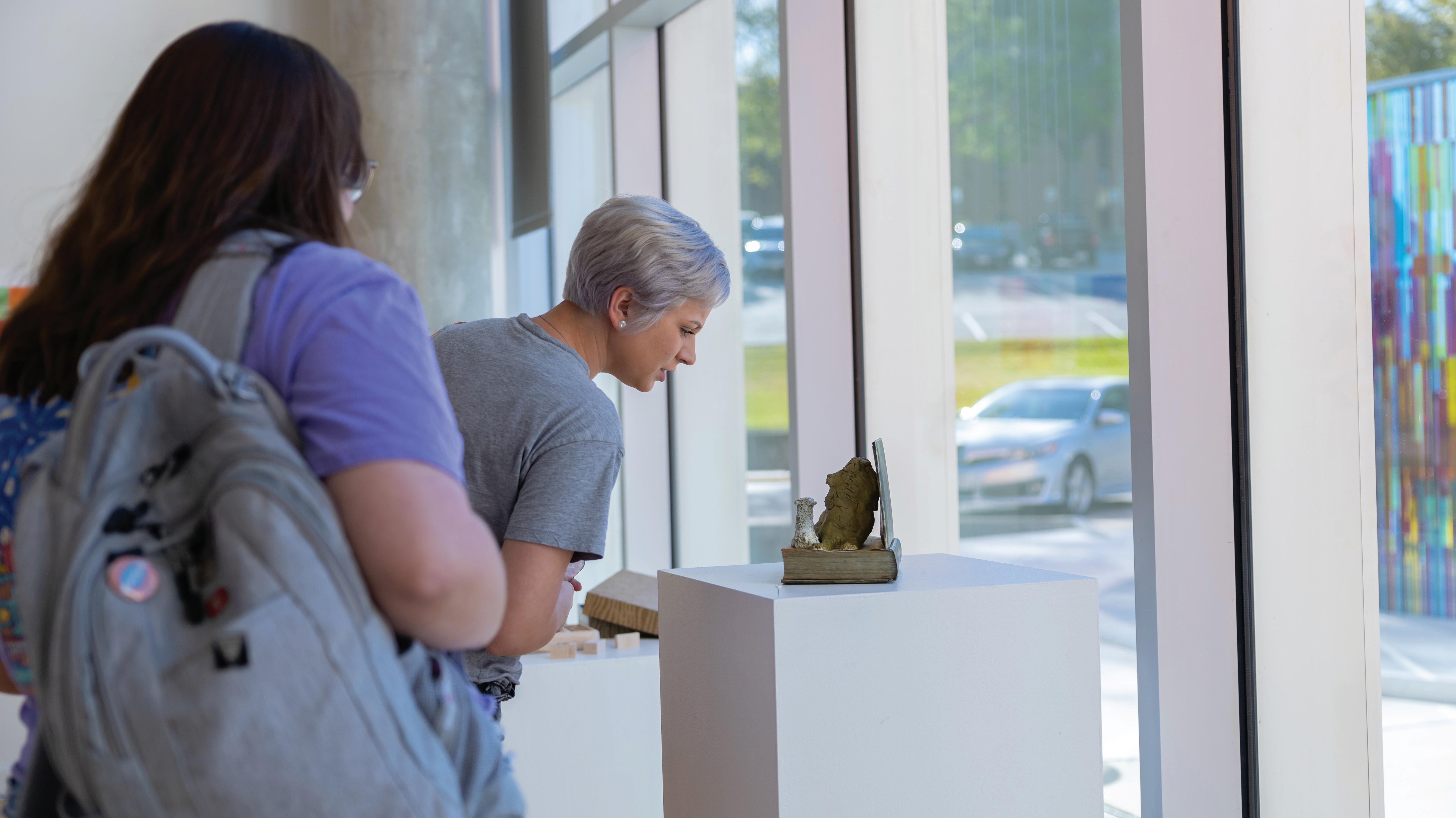
15 | CAM Magazine, Fall 2022
DEPARTMENT OF ART
Home to several nationally recognized degree programs, the Department of Art provides students access to contemporary digital labs and creative studios in a multilevel technology-enhanced complex. A vibrant environment for creative research and collaboration, the Department of Art is committed to personal and professional development by promoting original thinking and supporting the local community.
 BY JULIA MAY
BY JULIA MAY
Located within the Dana G. Hoyt Fine Arts Building is an area that has been specifically designed to give first-year art students the space and ambience they need to learn, create, and push through perhaps the most rigorous and challenging program they will face during their academic careers.

WASH, which stands for Workshop in Art Studio and History, has been stimulating the minds and efforts of first-year art students for almost 15 years. It is a threecourse, nine-credit hour, mandatory program structured to provide the framework that students need to succeed in their upper level classes.
“WASH strives to make sure students who pass the program are prepared with work to contribute to their BFA portfolio review,” said Jessica Simorte, coordinator of WASH. “It’s important to us that WASH students are introduced to a wide variety of media and artistic processes while learning about major concepts in contemporary art.”
Art professor Tony Shipp was chair of the department in 2008 and brought the idea with him from the University of Florida where he had studied. Sam Houston State’s program is based on UF’s Workshop for Art Research and Practice, although it has evolved into its own unique and distinctive entity over the years.
“We needed the WASH program at SHSU because we noticed that our students in the traditional 2D and 3D design courses were learning about the principles of design, but they weren’t learning how to apply those things to express ideas,” said Michael Henderson, current chair of the Department of Art.
“We also realized at the same time that they weren’t learning about contemporary art, nor what was going on in contemporary art, until their senior year when they took courses in contemporary art history and theory,” he said. “We thought it was important that they learned some things about contemporary art practices and ideas at the beginning of their curriculum, as well as at the end.”
The semester-long classes are time consuming, eye opening, and pushes students to think in ways they haven’t been asked to before. The students are encouraged to work with mediums they are not familiar with, often making their projects hard to visualize and difficult to create.
“We are hoping that the students learn discipline and time management skills right at the beginning of their academic career so that they can be more successful both in their collegiate and professional journeys,” Henderson said. Each studio class requires six projects a semester, all of which have goals for students to meet that correlate back
to the objectives of the program and syllabus. The classes are team-taught by two faculty members who are in the classroom at the same time.
“Because some of the sections are quite large, team-teaching means all class needs are met,” Simorte said. “Having two instructors allows for extra attention and feedback — something essential in an art studio. We also break up the class into smaller groups, which makes things like critique and demonstrations more effective,” she said.
Faculty members include those already teaching in the department from a variety of disciplines who are specifically assigned to teach WASH in a given semester, as well as adjunct faculty, some of whom are practicing artists from the Houston area.
“WASH is not medium-specific,” Henderson explained. “Students do a little bit of everything — painting, drawing, photography, 3D, time-based media, and performance works.”


Students are divided into a Monday-Wednesday group, a Tuesday-Thursday group, and an evening group. Each group learns studio concepts based on surface and space. All three groups meet together on Friday for lecture, the third component of the program.
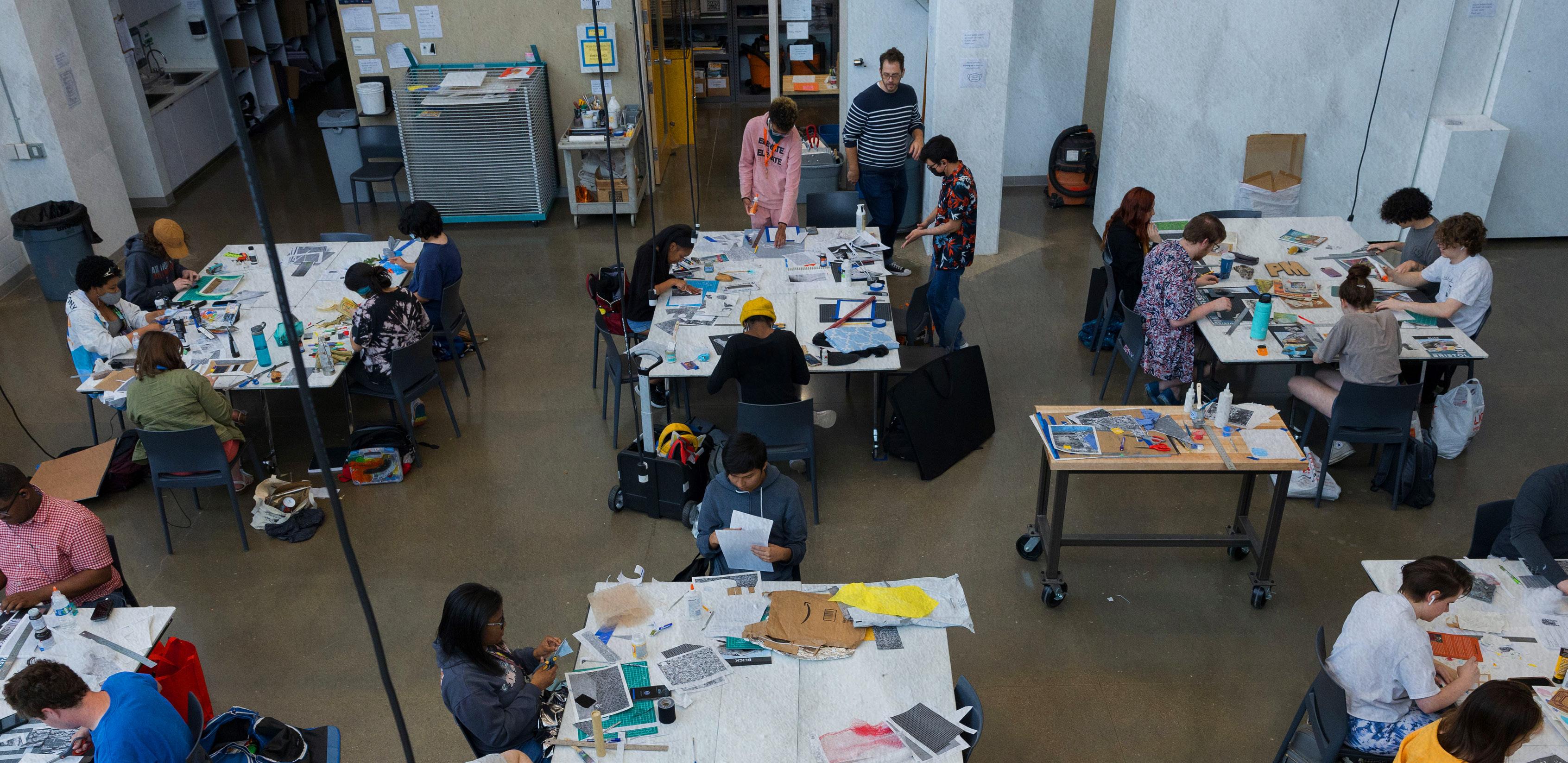
17 | CAM Magazine, Fall 2022
“The students form cohorts, which is an intended result of this program,” Henderson said. “They bond and support each other. They learn skills and concepts that are foundational to all of the art degree programs, and they learn how to apply those skills and concepts in other programs, whether it is animation or photography or studio art or graphic design.”

They also learn critique skills — how to talk about their work, how to talk about each other’s work, how to look at a piece critically, and how to develop problem-solving skills. The lecture component of the program is writingenhanced so that students will learn how to write about and assess their own work, as well as be prepared for the writing requirements of the art history classes they will be taking later.
“We know that students in the program are successfully accomplishing expected goals, because after we introduced WASH, we noticed a dramatic change in our students’ familiarity with contemporary artists in upper level classes and their ability to comment on and discuss what we were teaching them,” Henderson said. “We also noticed that they had become better at discussing their own and others’ work during class critiques.”
the classroom.

“The students do a lot of group projects in WASH, and we have been pleased to see how they team up right away when they are given a group project in their advanced classes,” Henderson said. “We don’t have to spend a lot of time organizing the groups. They are used to the idea of collaboration, so they are ready to go.”
The curriculum changes from year to year, primarily based on the desire to fold in some fresh projects, as well as gauging student outcomes and interest, according to Simorte.
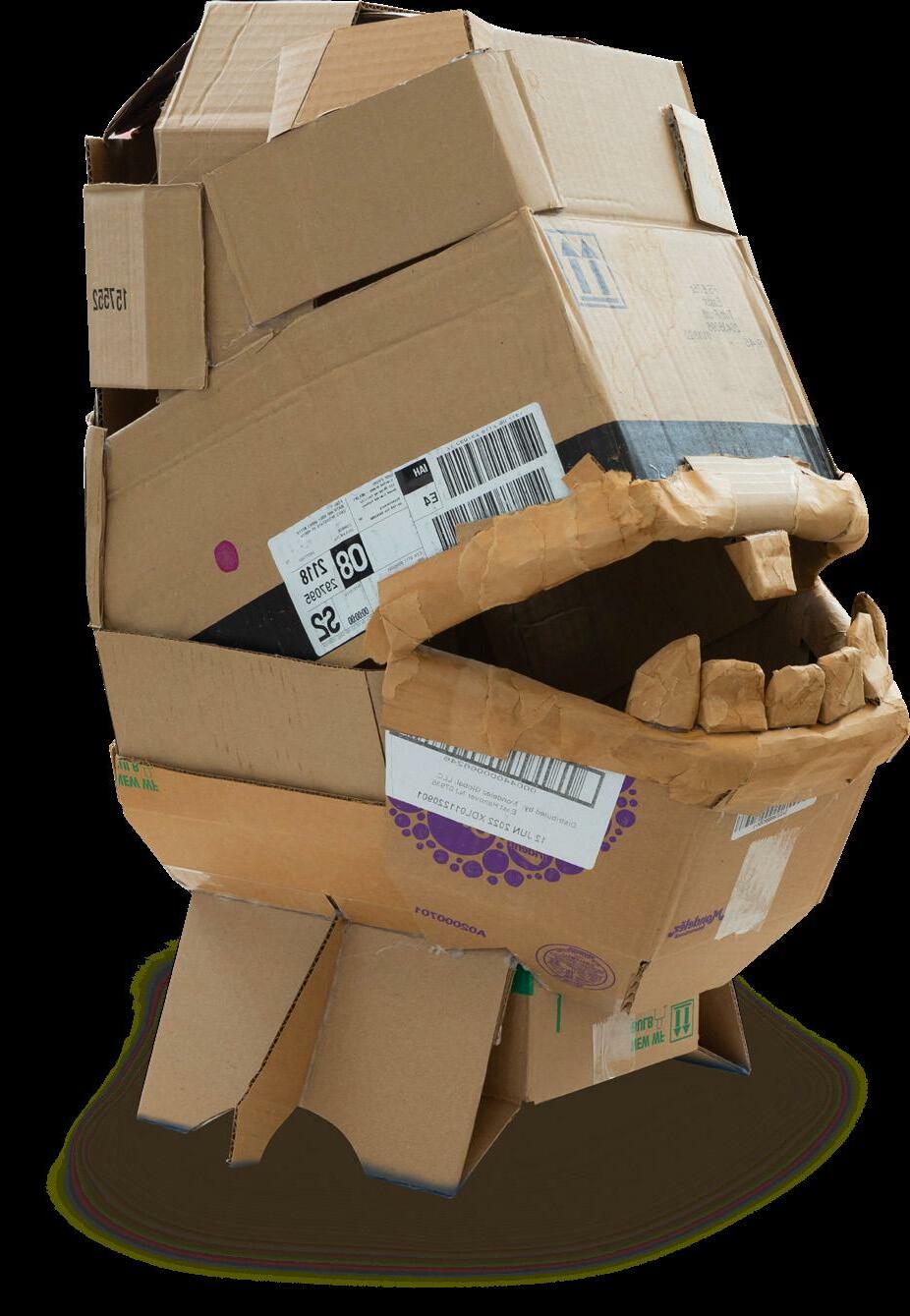


WASH faculty meet every August to discuss any objectives that need updating based on the year before. Projects differ from section to section, but the curriculum is consistent across all sections, and all the faculty members are tasked with providing a strong foundation for students to succeed in their upper level courses.
“WASH lecture discusses themes and major cornerstones of contemporary art, so if there’s something relevant happening in the art world, we are definitely excited to talk about it,” Simorte said.
And how do the students feel about the WASH program?

“We often hear students who are currently enrolled in the program complain about how hard it is, how much time it takes out of their day every day, and how much it consumes them,” said Henderson. “However, later in the upper level classes, we hear them say how valuable the program was for them.”
Simorte agrees, also noting that the benefit is two-way.
“WASH is the kind of program that sets up opportunities for significant student growth, and seeing our students leave with acquired skills and a lot of new artwork impresses me semester after semester,” she said. “Our students learn so much within their foundations courses, but we learn a lot from them, too.”

“In a collaboratively taught environment, students are able to see two different teaching-artists demonstrate the value of teamwork.”
Jessica Simorte
19 | CAM Magazine, Fall 2022
A Q&A ON THE WORKSHOP IN ART STUDIO & HISTORY (WASH)
WHY IS STUDYING ART VALUABLE?
“I chose to study art because when I was struggling heavily with my mental health at certain points in my life, creating art was one of the only things that could pull me out of any slumps I was having. Even in the midst of all the terrible things we see every day, art is a tool that can be used to bring people together, and that alone makes studying art so important and valuable.”
WHY DID YOU CHOOSE SHSU?
“I initially chose SHSU because my older sister attended and loved studying here, and in my freshman year alone, I have found so many supportive professors and faculty members here.”
HOW DO WASH STUDENTS WORK TOGETHER AS A TEAM?
“WASH students spend so much time together, so it’s inevitable that we become close with each other, especially in our smaller table groups! There is a lot of encouragement that goes into each project, and we all work together to get each other through it. It is especially nice to have this support from your peers when you’re having a bad week. I personally don’t think I would have
made it through the rigorous work without my tablemates. We hyped each other’s work up constantly, and it was really comforting to know that we weren’t in this alone. We also reminded each other of upcoming deadlines and events — for our WASH Lecture course, where we must attend 10 events for credit — so that no one was left behind.”
HOW IS A TYPICAL DAY IN WASH STRUCTURED?
“A typical day as a WASH student consists of attending the 2D WASH class from 8 a.m. to 10:50 a.m. where we are working on whatever current project we’ve been assigned, depending on where we are in the course. We then have an hour-long lunch break until noon, when we attend the 3D WASH section until 2:50 p.m. where we are working on one of our 3D projects for that week. Usually, after classes were out for the day, I would head home and work on my projects for specific amounts of time that I’ve set aside for that day if I didn’t achieve everything I wanted while in class. The workdays for these classes provide so much time to work, so I usually didn’t have to stress that much after class.”
WHAT ARE THE MOST REWARDING AND MOST CHALLENGING ASPECTS OF WASH?
“The most rewarding thing about the WASH program was being able to actually see the progress in my work near the end of the semester. It was so rewarding to be able to acknowledge my own talent and skills, which is something a lot of art students don’t do often enough. The most difficult part of the program was definitely time management for me, as I was also working and trying to balance everything. I had sort of reached a really good balance near the end, but I wish I had been better about planning at the beginning of the semester.”
WHAT ADVICE DO YOU HAVE FOR THOSE CONSIDERING STUDYING ART OR NEW STUDENTS IN WASH?
“Take everything in stride. It’s so easy to get caught up in the big picture and overwhelm yourself early on with coursework that requires so much of your time and effort, but it’s best to keep organized and remember that there are so many students that are working alongside you, so never be afraid to ask for support!”
Featuring Peyton Hines, Animation Major from Bryan, TX
CAM SPOTLIGHT

MFA Candidates in Art & Social Practice



 PATRICK RICHARDS MFA CANDIDATE ART & SOCIAL PRACTICE
From left: Glenda Denton, Magdalena Mendoza, Marcelle Cavazos, and Patrick Richards
PATRICK RICHARDS MFA CANDIDATE ART & SOCIAL PRACTICE
From left: Glenda Denton, Magdalena Mendoza, Marcelle Cavazos, and Patrick Richards

23 | CAM Magazine, Fall 2022
DEPARTMENT OF DANCE
Where creative expertise meets performance, the Department of Dance offers a dynamic and challenging curriculum. Students evolve into the next generation of career-ready dance professionals with access to multiple rehearsal studios, a fully equipped Pilates studio, a dance technology lab, and a performance theater.

COLLABORATION CHOREOGRAPHYand
Beyond the beautiful moves that audiences view at a performance of students enrolled in the SHSU Department of Dance are hours and hours of practicing, creating, training, and classroom lectures, among so many other requirements.
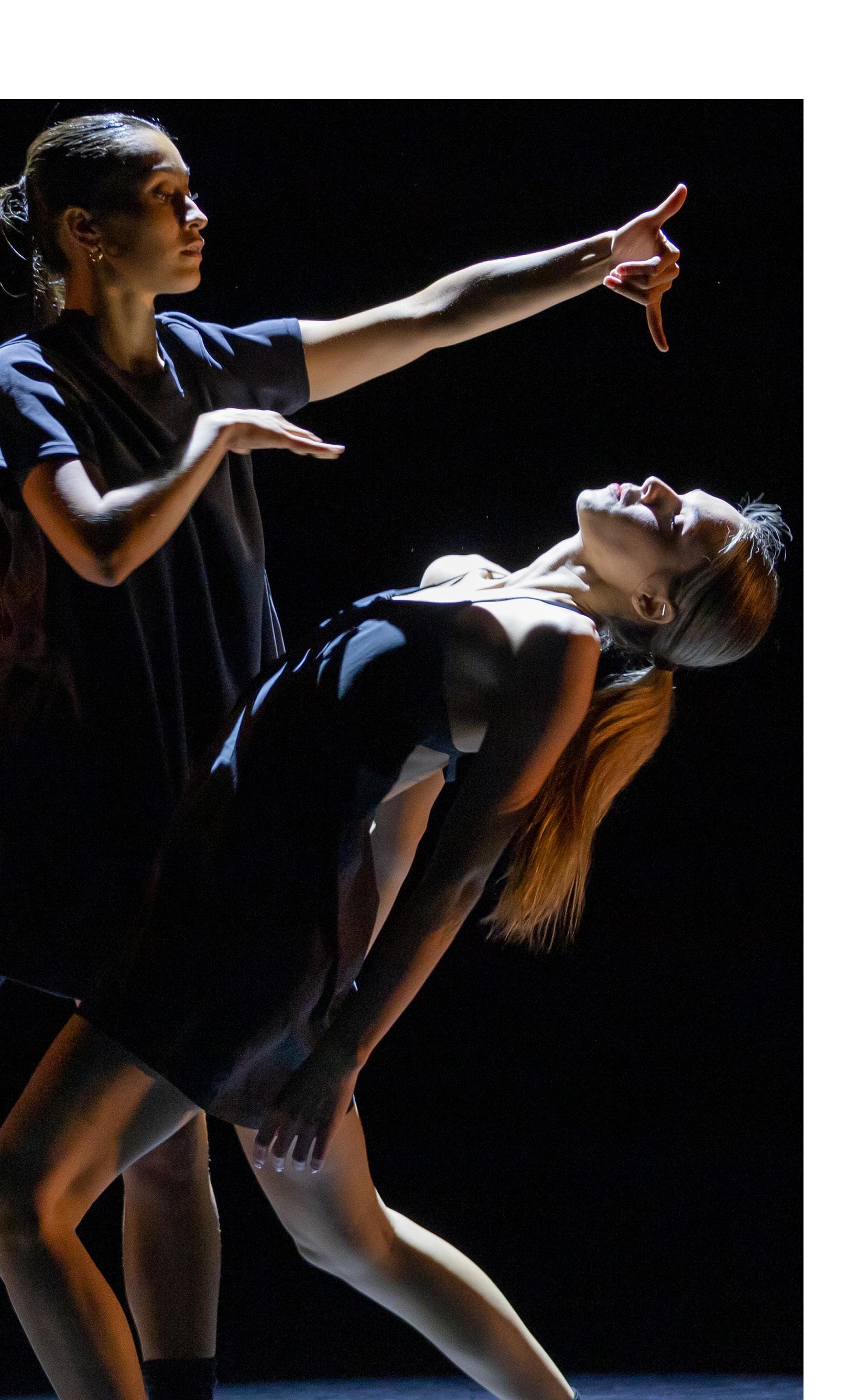

Like many graduate students at SHSU, most dance grad students have jobs to pay for their college expenses. Some are teaching assistants or graduate assistants in the department. Some teach in area dance studios, and some work in other non-dance related jobs across campus and even off-campus. It’s often very difficult for these students to find opportunities to build a strong performing portfolio when almost every minute of their time is allocated for a specific task.
Fortunately for SHSU dance graduate students, a student organization provides additional performance and choreographic opportunities in a convenient setting, as well as skill building in leadership, concert organization, rehearsal scheduling, and marketing. the process for forming a student organization at SHSU The Masters of Dance organization (also known as MOD) was formed to provide a platform for MFA dance students to explore, discuss, and present one’s artistic vison through annual professional level, fully produced dance performances.
— DIONNE NOBLE associate
professor of dance, graduate advisor, and advisor for MOD
“In 2016, two graduate students, Rasika Borse (now faculty) and Victoria DeRenzo, saw an opportunity to form a student organization at the graduate level that would unify their community,” she said. “Together they worked with the other graduate students to develop the central ideas for the student organization, research the process for forming a student organization at SHSU, and author the constitution and bylaws that were submitted to form Masters of Dance.”
”
25 | CAM Magazine, Fall 2022
written by Julia May
Madelyn Klumb served as MOD’s 2021–2022 president. MOD officers also include a vice president, treasurer, and a concert director. The concert director organizes the concerts and assigns tasks to members.
“For example, we normally need someone to teach warmup classes, we need ushers, we need people to gather music for the show, and we need choreographers,” Klumb said. “The concert director handles all of that, and my job as president is to make sure everything is on track.”
Although membership is not mandatory, each dance graduate student is automatically a member of MOD, even if they choose not to create something for a MOD concert.
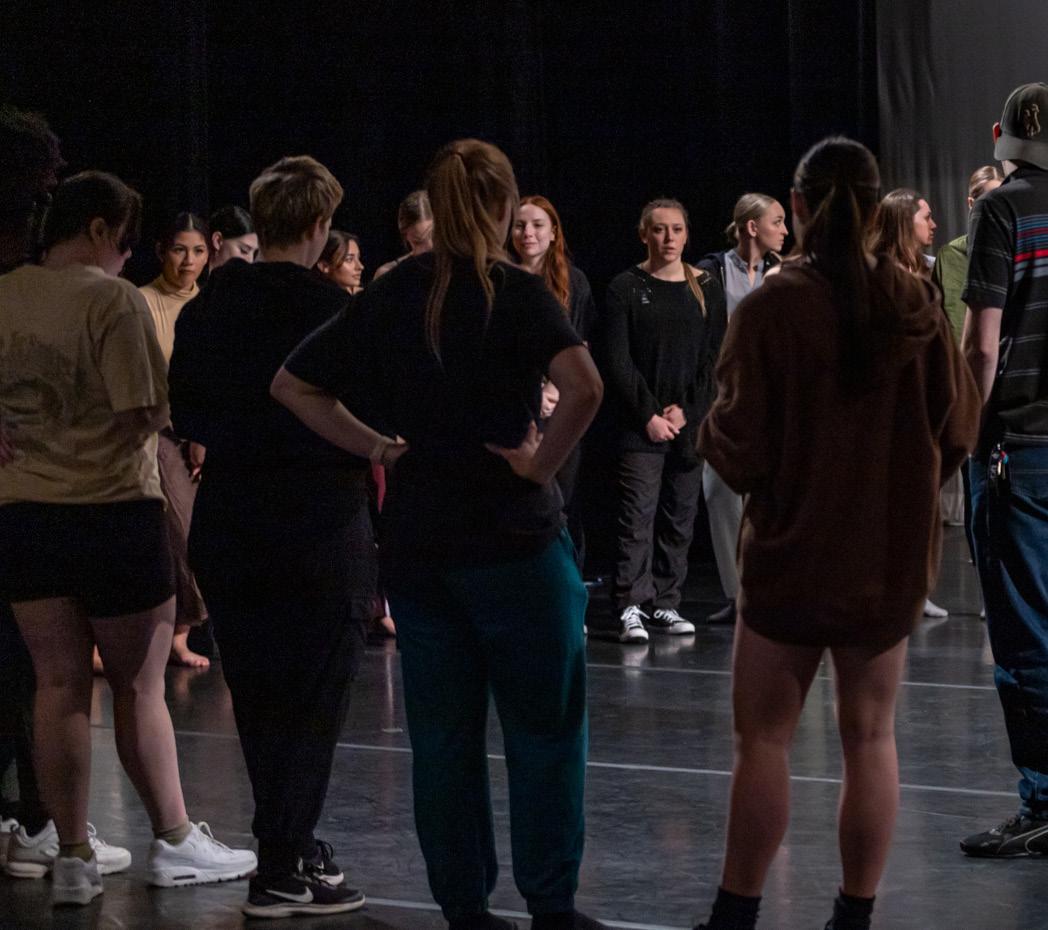
“We have auditions the first week of each semester for those who are interested in choreographing for the concert,” Klumb said. “Undergraduates also audition to dance in our pieces.
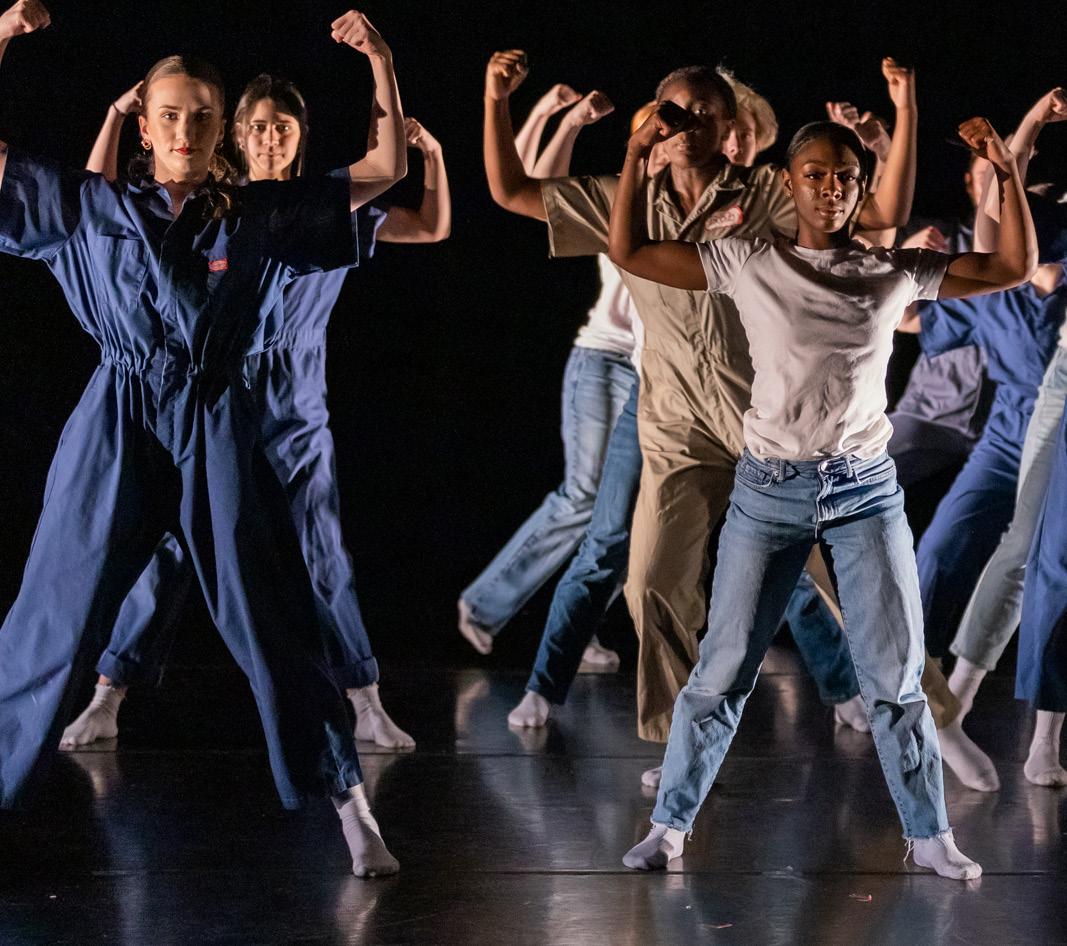
“From there, the choreographers will announce dates and times for rehearsals. We have to work around faculty rehearsals, senior studio rehearsals, and a lot of other things. Our normal time to practice is 8 to 10 p.m., twice a week,” she said.
“The process requires a collaborative effort among all the MOD members and results in a bonding experience,” according to Klumb.
“We rely on everyone to pitch in and do their part to help out. We have our leaders and directors who manage the concerts, but our concerts would not run as smoothly as they do without the other grads helping as well,” she said.
The organization meets once a month and has a special meeting before concerts to finalize details.
“We talk about our pieces, the mood of the piece, how long it is, and which dancers you are using so that when we are establishing the order of the show, we don’t schedule one dancer in three back-to-back pieces,” she said.
Neal Petz, a production specialist for the college, helps with their lighting requests. One of the dance graduate students, Jam Martinez, also worked with his classmates to design lights for their dances.
The performers are responsible for obtaining their own costumes.
“I try to make everything as stress-free as possible, so I give the dancers a lot of options,” Klumb said. “ We are blessed to have a lovely costume closet that we can pull from, as long as the costumes are not already being used. We can buy the costumes or make them ourselves, although most of us haven’t done that because it takes so much time. Sometimes we already have costumes in our own closets.”
The music used by the choreographers comes from a variety of sources. Sometimes, they compose the music themselves.
“We have learned in some of our classes how to compose music using a computer app such as Garage Band,” said Klumb. “Some of us have a musical background, or we played an instrument, or were in a band. It’s just based on preference or experience.”
Performers also have the option of collaborating with other artists. One graduate student found a pianist in Washington and worked with that person to create a sound score for her thesis.
“The things we do in our concert preparation now will also show up in our future careers,” Klumb said. “Some of us have had the opportunity to participate in similar activities as an undergraduate, and some haven’t. Whether you have the experience or not, it’s good to have this opportunity to continue practicing and gaining those skills.”
The experience has another educational benefit, as well.
“What makes our co-hort so amazing is that we all come from different backgrounds, and we all have knowledge in our pockets,” she said. “We are not going to keep that knowledge to ourselves and not share it. We all can contribute new information to create this process and make it happen.”
The SHSU dance faculty supports the group with their attendance at concerts. They also recognize the contributions of the grad students through their membership in MOD.
“I see the organization as providing leadership opportunities for the graduate students while they are in residence,” Noble said. “MOD is often asked to provide support for departmental activities, both internally and externally. They are often asked to serve as ambassadors for the department and as mentors for the undergraduate students in many ways.
“Through its programming, members learn to be resourceful as they work with one another for common goals,” she said. “Masters of Dance provides a selfgoverned way for students to take risks and be creative in a supportive environment. Every year, I am inspired by what the students produce through this organization.”
27 | CAM Magazine, Fall 2022
A Q&A ON THE GRADUATE STUDENT ORGANIZATION MASTERS OF
WHY IS STUDYING DANCE VALUABLE?
“As a child who did not fit in the typical society in Japan, participating in performing arts was something that made me feel empowered. Besides dance, I played the cello seriously, but I eventually chose dance because I felt most connected to it. It involves many aspects one can apply in many other fields. As we spend a lot of time in studios, it requires human interactions and problem-solving skills, such as figuring things out on the spot and asking peers for their feedback. Learning movement and performing the movement requires the skill to process a task in a short amount of time. And last but not least, studying dance is valuable because it is a valid mode of inquiry; however, it is often undervalued in academia due to its somatic, non-verbal approach. The ways dance is researched can involve more in-studio physical activities than in other fields in academia.”
WHY DID YOU CHOOSE SHSU?
“I chose SHSU because of its family-like community and many career development opportunities. As I earned my BFA in Dance from SHSU in 2012, I already knew how amazing the SHSU dance community was. However, one of the most important factors was that this program was constantly growing. I kept seeing amazing updates on social media throughout the years until I returned as a graduate student. Over the past decade, more wellrenowned choreographers have come to the program. This program has been recognized many times at American College Dance Festival Gala Concerts and Nationals.”
HOW DOES MASTERS OF DANCE WORK TOGETHER AS A TEAM?
“For the organization itself, we normally have four officers — president, vice president, secretary/treasurer, and concert director. I served as a secretary/treasurer during my second year. I was in charge of keeping records of monetary transactions and fund-raising. For MOD concerts, many members participate as choreographers. In addition, led by the concert director, we designate people for materials for public relations, poster designs, programs, and casting auditions. Each semester, two or three of the choreographers prepare audition phrases to teach the dancers who audition, and all of the choreographers observe the audition. Then, we meet together to discuss casting for each choreographer based on the dancers’ schedules and studio availabilities.”
HOW IS A TYPICAL DAY AS AN MFA STUDENT STRUCTURED?
“A typical day looked different based on what year I was in, but here is an example from Spring 2021 (my second year), which was one of the busier semesters:
8:00 a.m. | Get up and eat breakfast
9:30 a.m. | Assist a professor teaching
11:00 a.m. | Take Seminar in Dance Production
12:00 p.m. | Lunch
1:00 p.m. | Teach Ballet III
2:30 p.m. | Take Modern IV
4:10 p.m. | Rehearsal for my Masters of Dance piece
7:00 p.m. | Dinner, homework, and free time However, once I was in my third year, I was able to spend a lot of time focusing on my research and take fewer courses.”
DANCE (MOD)
WHAT ARE THE MOST REWARDING AND MOST CHALLENGING ASPECTS OF MOD?
“The most rewarding thing about being a part of MOD is the community we build with these amazing fellow grads. I learned so much from taking courses at Sam, but I also learned a lot from my peers, who are fantastic artists. I got to see their wonderful works on a daily basis, and they always inspired me. The most challenging part was being an officer while taking many classes, teaching classes, and participating in rehearsals.”
WHAT ADVICE DO YOU HAVE FOR THOSE CONSIDERING STUDYING DANCE OR NEW GRADUATE STUDENTS?
“Look for a research topic that really interests you. Being in grad school was very challenging, but it was totally worth it. When I passed my thesis defense and oral exam, I realized how much I had learned and became knowledgeable in the field I had researched over the three years.”
Featuring Shohei Iwahama, MFA from Hachioji City, Tokyo, Japan
SPOTLIGHT

Madelyn Klumb

CAM


 MADELYN KLUMB
MFA CANDIDATE DANCE
“Textured Walls (The Walls Are a Beach)” by Madelyn Klumb in collaboration with pictured dancer, Sophia Green.
MADELYN KLUMB
MFA CANDIDATE DANCE
“Textured Walls (The Walls Are a Beach)” by Madelyn Klumb in collaboration with pictured dancer, Sophia Green.

31 | CAM Magazine, Fall 2022
DEPARTMENT OF MASS COMMUNICATION
In the Department of Mass Communication, students learn how to run the show just as they will in various fields of professional mass media. The hands-on curriculum is centered around building a network of informed, ethical, and technologically proficient communicators who are prepared to make a positive impact on the rapidly changing world of media.
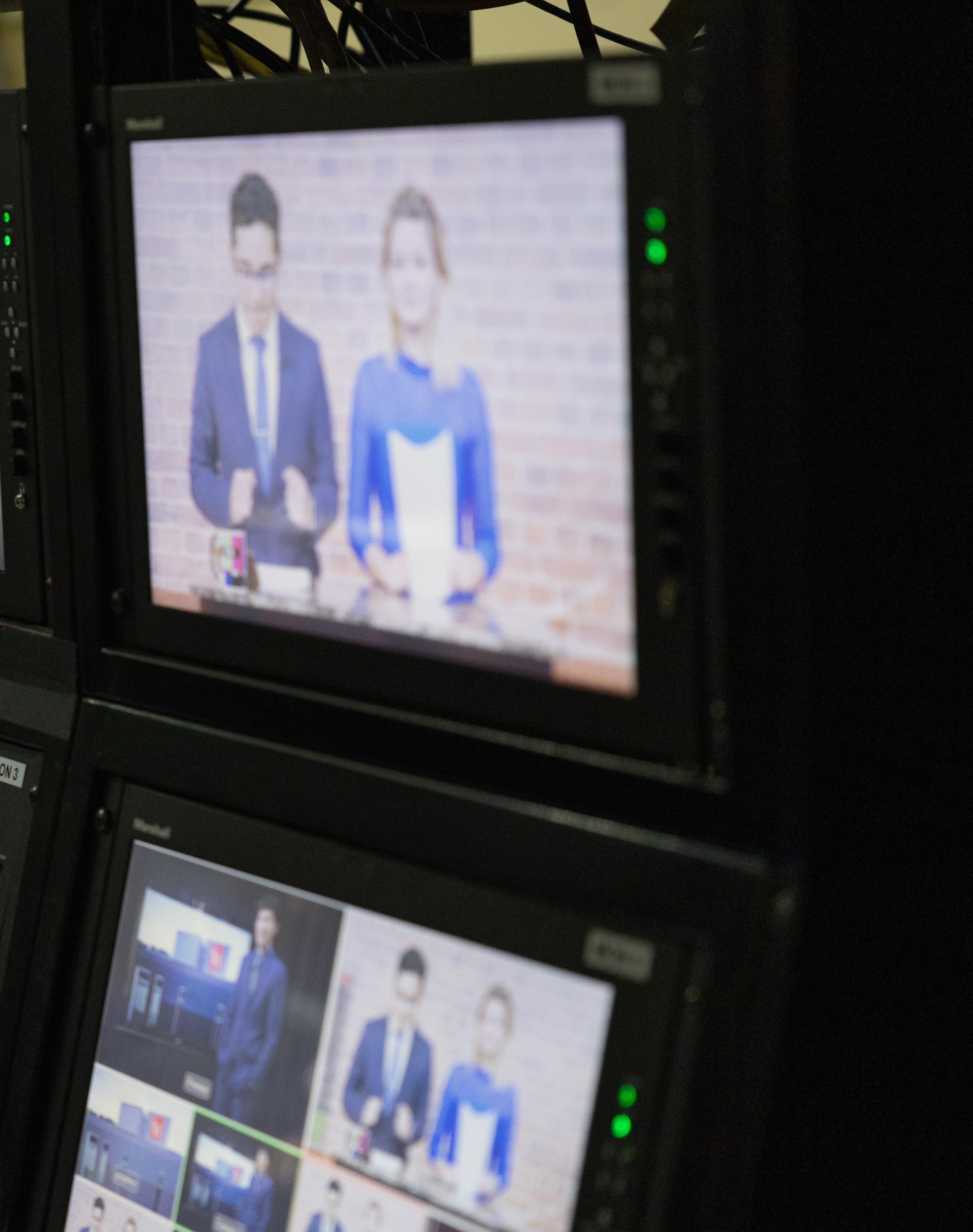
JOINT EFFORTS IN JOURNALISM
written by Julia May
On Tuesday and Thursday mornings for many years, students, faculty, and staff would look in the familiar newspaper boxes strategically placed across campus for the latest edition of The Houstonian student newspaper.

Sometimes with eager anticipation, sometimes with dread, readers from administrators to students would eyeball the print to see if they had been featured, quoted, or pictured along with the latest news at SHSU.

However, technology and the arrival of COVID-19 altered the way the newspaper is delivered. No longer is the paper only a hard copy that students can thumb through while waiting for class to begin. Readers now have the option to download the most recent issue on electronic devices, open a newsletter issue through email, or log into their favorite social media platforms for updates.
One thing that has not changed is the learning laboratory The Houstonian provides for students looking to have authentic work experience before graduation.
Former editor Dan Rather once said, “Everything that has happened professionally since I left Sam Houston, every good and decent thing, every piece of luck and God’s grace I’ve experienced, I think can be traced directly back to my time working for The Houstonian.”
Scott Morris, who served as The Houstonian’s editor during the 2021–22 year, agrees. He credits his time spent with The Houstonian with giving him the confidence and leadership skills that will help him throughout his career.
33 | CAM Magazine, Fall 2022
Although Morris started out in sports broadcasting, he soon discovered that print journalism was a better fit for him.
“In the spring of my freshman year, there was a meet-andgreet with SHSU alumnus David Brady who is the gameday announcer for the Texans professional football team,” he said. “At that event, I told him that I liked sports and wanted to work in that world.
“The Houstonian sports editor was there and afterwards he invited me to come in and talk with him. He asked me if I would like to do some writing,” said Morris. “I’ve always liked writing, but I had never done anything with it, so I thought, why not?”
He worked his way from staff writer to sports editor to editor-in-chief.
“Most students who come to work for The Houstonian usually have some journalism background, writing experience, and a portfolio of their work,” he said. “I had no experience whatsoever. But I listened to people along the way, I never said ‘no’ to a project or assignment, and I took every opportunity I could to learn.
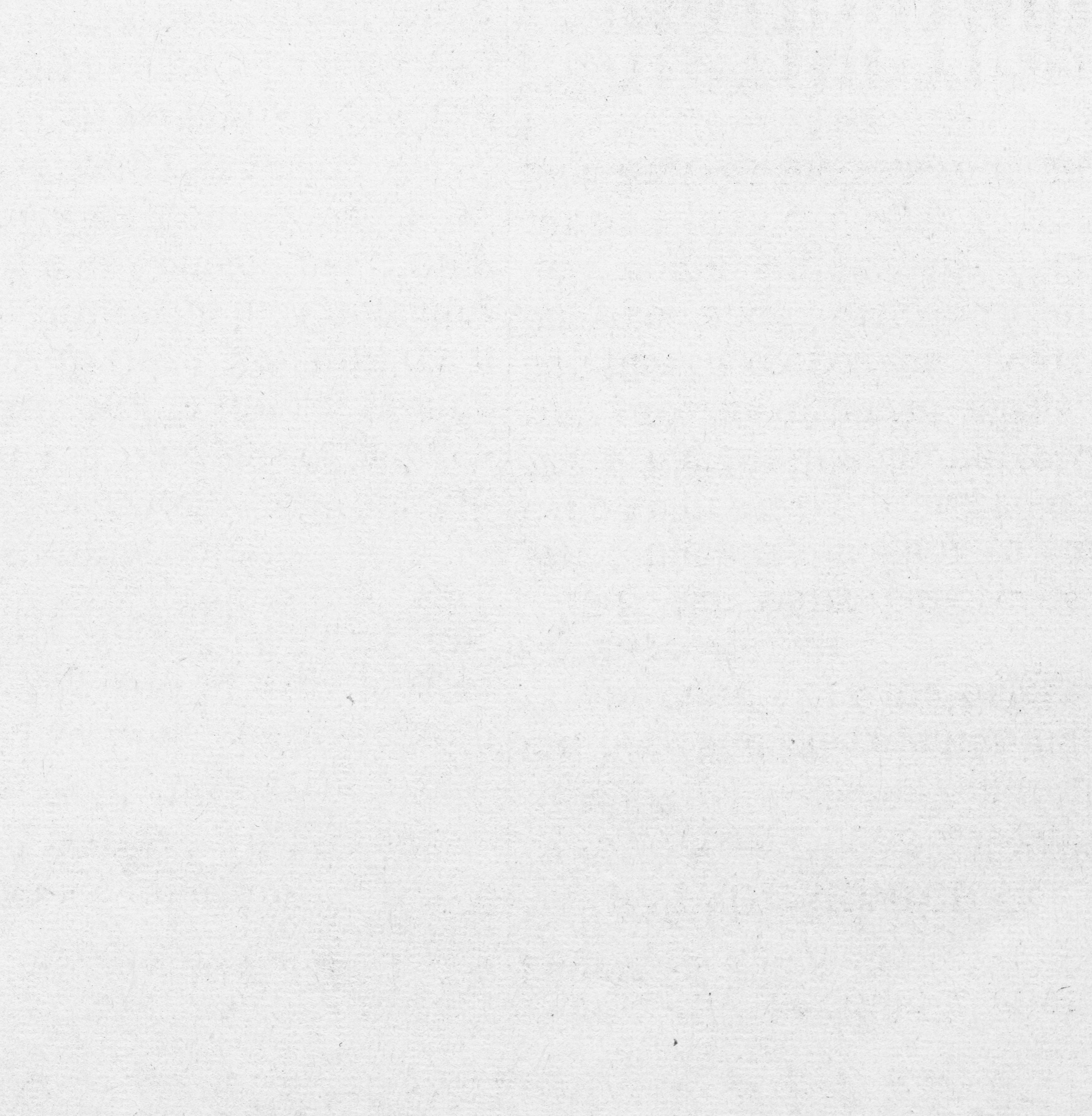
“I always tell people it’s ok to be nervous because you don’t think you have enough experience,” he said. “Everyone has to start somewhere, and SHSU is one of the best places to start.”
Even though surveys indicate that more and more people are getting their news electronically, Morris is not convinced that the traditional print newspaper is on the verge of extinction.


“Even with digital content, you still need good writers, photographers, and designers,” he said. “Also, I believe that there will always be people who enjoy the feel of a newspaper in their hands, just like there are people who prefer reading a hardbound book to reading on an e-reader.”
Michael Garcia is the arts and entertainment editor for the newspaper. In addition to the experience he has gotten with multi-platform media, he appreciates the way he has learned to work in a professional newsroom setting.
“Being on The Houstonian introduces you to a whole new team experience,” he said. “When you first come into a newsroom and start writing, you quickly learn that you’re working with different personalities, different working styles, and everyone’s work affects someone else.

“Then, you have to sharpen your communication and organization skills. How do you reach out to someone to set up an interview, how do you interact professionally with them, did you do enough background work so that you can ask smart questions,” he said. “Sharing ideas and learning new techniques from the others on staff really helps.”
Morris noted how grateful he was for the support and encouragement he got from faculty, as well as upperclassmen when he first began.
“Tyler Josefsen was the editor when I first came to work for The Houstonian. He was the one who told me I had talent and should stick with writing,” Morris said. “Then of course our advisor Debbi Hatton and assistant professor Ryan Broussard were both great to show me the professional side of journalism and give me guidance in being a strong editor and team manager.”
Morris says he has tried to be the kind of role model as editor-in-chief that Josefsen was to him and other young staff members.
“My favorite part of serving as editor has been working with the team,” he said. “The newsroom can be stressful with deadlines, but at the end of the day everyone wants to achieve the same goals. The team has been my saving grace throughout college, the very best thing that has happened to me.”
When asked what he thought the strength of The Houstonian is after more than 100 years of existence, Morris said, “Being able to give a voice to the students. As long as The Houstonian is the voice of the students, is informative, and continues to tell campus stories with integrity and purpose,” he said, “it will be a major part of Sam Houston State University’s culture.”
35 | CAM Magazine, Fall 2022
WHY IS STUDYING FILM & TV PRODUCTION VALUABLE?
“Studying Film & TV Production is valuable because it gives you both the resources and the experience to enhance your portfolio for whenever you go out into the field, and it also gives you networking opportunities to expand your reach to potential clients. A lot of the jobs and opportunities I’m working with and working towards wouldn’t have happened if it wasn’t for my experience here. This program also gives you a lot of room to expand your creativity within the assignments that you take on. The professors are really good at giving their fellow students the space and resources in order to create the best kinds of films and video content they can make.”
WHY DID YOU CHOOSE SHSU?
“I chose SHSU because it’s an accredited university with a really good film program, and it’s not overly expensive for the high-quality education you receive. Ever since I was a kid, I’ve always wanted to make movies, and just overall be a part of the filmmaking process. When I went to community college, I got my first video job in a studio within that college, specializing in educational content and creating promotional content to make students more aware of all the resources available to them. Once graduation drew near and I was looking for colleges to transfer to, my boss recommended Sam Houston since it was an affordable, accredited institution that had a specialization degree for Film & TV production within the Mass Comm department. I applied, submitted my portfolio for review, got in, and the rest is history.”
A Q&A ON FILMMAKING
HOW DO FILMMAKERS WORK TOGETHER AS A TEAM?
“The filmmaking process is fully reliant on teamwork. Every single student that is in this program has a specific niche that they’re good at. As an editor, I’ve worked with students that are directors, cinematographers, audio designers, writers, and even students that specialize in hair and makeup. Every single student is proficient at something different, and every single role is important for getting the final product out there.”
HOW IS A TYPICAL DAY AS A FILM & TV PRODUCTION STUDENT STRUCTURED?
“A typical day as a film student really depends on what classes you’re taking that semester since each different class covers different parts of the filmmaking process. However, no matter what, every class period is very project-focused. Every day that you enter a classroom, studio, or computer lab is another day that you’re chipping away at something bigger, whether it’s training for a really big multi-camera shoot or working with your peers on completing a short film that’s due at the end of the semester. It’s a near guarantee that after every semester, you’ll have something new and unique to add to your portfolio.”
WHAT ARE THE MOST REWARDING AND MOST CHALLENGING ASPECTS OF FILMMAKING?
“Personally, the most rewarding part of the filmmaking process is watching the final cut one last time, right before you send it out to your peers. It gives the whole process a nice resolution, seeing the result of all the long hours everyone spent writing, planning, shooting, and editing, and really puts into perspective all the hard work everyone had to put in to make sure the final film comes out just right. The most challenging would have to be conceptualization. Creative burnout is very real, but we also have to consider actualizing the concept on a college student budget and schedule. ”
WHAT ADVICE DO YOU HAVE FOR THOSE CONSIDERING STUDYING FILM & TV PRODUCTION?
“If you’re at all interested in doing Film & TV Production for your career, just know that if you choose SHSU, you’re going to get out what you put in. Get involved, make friends, and make connections, and I promise you that you’ll leave here with more knowledge, connections, and opportunities than you came with.”
Featuring Steven Romero Jr., Film & TV Production Major from Tomball, TX
Coby Lobaugh


CAM SPOTLIGHT


 COBY LOBAUGH CREATOR LONE STAR STORIES
Coby Lobaugh interviewing Cherelle “Torch” George #10. Photo by Grace Cambell.
COBY LOBAUGH CREATOR LONE STAR STORIES
Coby Lobaugh interviewing Cherelle “Torch” George #10. Photo by Grace Cambell.

39 | CAM Magazine, Fall 2022
SCHOOL OF MUSIC
A devoted community, the School of Music is composed of internationally recognized performers, scholars, and educators. The diverse talents of student and faculty musicians are celebrated through an array of vocal, instrumental, ensemble, and chamber performances.
 by Julia May
by Julia May


41 | CAM Magazine, Fall 2022
Each fall, collegiate football fans eagerly await the beginning of the season, particularly in Texas, where the sport is undeniably one of the state’s most treasured traditions.
In addition to the players and coaches, the spirit groups, and the excited supporters, a critical component of the game-day experience is the university’s marching band to provide entertainment, encouragement, and enthusiasm, no matter if the team is winning or losing.
Sam Houston State University has one of the premier marching bands in the state with a reputation for excellence among music educators who have either graduated from the university or been involved with some of its continuing education programs.

Although there are records indicating that the first unofficial band for the school was founded in 1910, it wasn’t until the 1920s that the band was officially recognized as an organization representing Sam Houston at football games, occasional parades, and public relations events. That is also the time that the school began using “Semper Paratus,” the US Coast Guard Hymn, as the fight song.
Among those leading the band through the years were Elliott T. Bowers, who later became the university’s president and for whom the current football stadium is named; Ralph Mills, a leader who significantly impacted the music education program in Texas; Rod Cannon, former director of the SHSU School of Music; and Henry Howey, currently senior faculty member and professor of euphonium in the School of Music.
Brian Gibbs, professor of music at SHSU, associate director of bands, and director of the Bearkat Marching Band, has overseen the program for 12 years. He taught at Texas Christian University and in public schools before coming to SHSU.
“Everything we do falls under the band motto, ‘Passion, Family, Excellence,’ which was created by members several years ago,” Gibbs said.

"That includes everything from our rehearsals to our performances, to how we handle ourselves in public."
The Bearkat Marching Band attends as many football games as possible, even if they are not scheduled to perform on the field.
“One of our limiting factors is the cost of transportation,” Gibbs said. “Our budget is set at the beginning of the fiscal year, and there is no way to know how long the football season is going to extend, depending on playoff games and the team’s success, or where they will be playing after the regular season, which also affects transportation costs. However, if we can accompany the football team, we do.”
Last year, when the Bearkats played for the National Championship and won, the marching band was there. They weren’t allowed to play at the game due to COVID-19 restrictions, but they took their instruments and played at the alumni reception the night before.
Bearkat Marching Band performances appear to run so smoothly that it’s hard to imagine how many individuals are involved in making the magic happen.
“We have our drum majors, of course, and their main role is to provide leadership and make sure everyone understands what the shared vision is,” Gibbs said.
The band also utilizes approximately four or five student assistants. These students have already been a part of the band for a couple of years, and they are now ready to learn how to handle some of the administrative tasks behind the scenes.
“They make sure we have purchase orders in place, that all the equipment is in order, and they are even responsible for making sure the band has drinks and snacks for halftime,” Gibbs said.
The band also receives support from Tau Beta Sigma, a co-ed organization which is tasked with moving equipment, setting up the field, and loading the equipment truck. Although most of the members of the organization are in the band, the only requirement is that you must be taking a music class.
Along with the students who play instruments, the Bearkat Marching Band is noted for the outstanding performances of the Color Guard.
“Tim LeBlanc is our visual designer. In addition to creating the drill design for the band, he works with the Color Guard and designs their choreography,” Gibbs said. “He works year round because he is also the director of the Winter Guard and has been wildly successful with that program which competes in the off-season.”
The Winter Guard allows students to round out their teaching skills beyond playing an instrument in the marching band. SHSU’s Winter Guard consistently wins awards in their competition category and advances categories with each win. Not only does the extra performing opportunity serve as a way for current Color Guard members to enhance their skills, but it also serves as a recruiting tool.
“Having our own drill writer in house and color guard instructor in house is just golden,” Gibbs said. “We give him the music that we have chosen, and he puts something together that we can learn quickly and makes the biggest visual impact. Every performance you see has been custom designed for us.”
Even the music arrangement on the field is unique to the Bearkat Marching Band.
“We are very fortunate to have Sean Nelson as our marching music arranger. Sean has a bachelor’s degree from Sam Houston, and he is now a staff arranger and member of the trombone section of the US Coast Guard Band,” said Gibbs. “He knows exactly what to do to get the biggest bang for the buck for us. He helps us with selecting the right pieces, including music that is a little more contemporary along with some that is a little bit older so that everyone in the crowd gets to hear something they might be familiar with.”
Another integral part of the band program is the twirling program.
“Kelly McCormick is our twirling coach and has helped us build the program. We now have Twirler Day and a Twirler Reunion. One of our former feature twirlers, Robbie Maloy, along with some of her friends helped establish a twirler scholarship fund to support the program,” Gibbs said.
The drum majors generally conduct everything that the band plays in the stands and everything on the field except the Alma Mater and the national anthem.
“We usually offer the opportunity to conduct the national anthem to people who have been supportive of the university, administrators, or alumni,” Gibbs said. “We have them come to band rehearsal on the Thursday night or Saturday morning rehearsal before a game. The biggest thing for our guest conductors is knowing how to get things started — the routine of the band getting their instruments into playing position and cueing and the drum roll, that sort of thing. It’s almost impossible to go off the rails because the band knows the national anthem well enough, and the drum majors are there to support the conductors. It’s such a wonderful thing to allow guest conductors to participate.”
Gibbs conducts the Alma Mater.
“I tell the band I do it so it looks like I’m doing something,” he laughed.
Darla McBryde, visiting assistant professor, is the associate director of the Bearkat Marching Band.
“Ms. McBryde has been with us three years,” Gibbs said. “With the implementation of a summer master’s degree, we really needed another person on staff. She and I share responsibilities, and she attends all the games and all the rehearsals. She has as much influence on the program as I do, and she has been priceless.”
Something Gibbs is looking forward to this fall is the arrival of new uniforms for the band.
“We have not had new uniforms since 2008. Normally the cycle of a band uniform is about 10 years, so we are a little overdue; but it is such a big expense,” Gibbs said. “Actually, the timing is working out beautifully because the new uniforms will incorporate the new athletic logo and reflect the new branding that went into effect last year. The colors will be the university’s official colors and the design will coordinate with the cheer and dance uniforms. I think when everyone sees them, they will be pleased.”
The new uniforms won’t be worn at the first couple of games because of the Texas heat.
Although Bearkat Marching Band representatives do participate in active recruiting missions, a lot of incoming students are already familiar with SHSU’s program from an early age.

“Throughout the year, the directors go across the state and help public school groups with such duties as
providing judging for all-region and all-state bands,” Gibbs said. “We also offer programs and opportunities for music educators year round. Our Center for Music Education (CME) puts on several summer workshops for new and veteran teachers that meet the requirements for mandatory continuing education credit. Some of the workshops are held on campus here at SHSU and some are held at Southern Methodist University in Dallas.”
For the convenience of music educators in the Houston area, the CME presents a workshop for credit each fall at The Woodlands Center campus. The director of the Center for Music Education and director of bands at SHSU is Matthew McInturf, professor of music.
The summer workshops are held in conjunction with junior high and high school band camps and are integrated into the curriculum for our Master of Arts in Band Studies degree, which can be completed over three summers of study.
“By the time students come into our program, they are very familiar with our traditions and expectations,” Gibbs said.
Even with the demanding time commitment for band students, Gibbs says having enough members for the band has never been an issue. Surprisingly, not all band members are music majors.
“Approximately 35 percent are non-music majors,” he said. “We’ve had many criminal justice majors, some non-traditional students who have gotten their bachelor’s degrees somewhere else and have come back for another degree, and we’ve had some band members who have gone on to medical school to become doctors.
“But all of our members are talented and love music, and they are a good fit for our program,” he said.
“It is a joy every time I stand before the band to conduct the Alma Mater,” he said. “I am so proud of the members, how hard they work, and how respectful they are. I see how much of themselves they give and how much they contribute to the overall success of our program. They personify the heart and spirit of the university, and we are fortunate to be a part of their journey while they are here.”
43 | CAM Magazine, Fall 2022
Rendering courtesy of Fred J. Miller, Inc. and designer Michael Cesario.

Everything we do falls under the band motto
- BRIAN GIBBS PASSION , FAMILY , EXCELLENCE
45 | CAM Magazine, Fall 2022
A Q&A ON THE BEARKAT MARCHING BAND (BMB)
WHY IS STUDYING MUSIC VALUABLE?
“I chose music because I realized at one point in my life that doing work for (only) money was never going to keep me happy. I would rather be happy with little money than be sad with a lot of money. I believe music is a vital component of the human experience. It’s the only language that is universally understood, and it allows for a method of communicating ideas and emotions without the use of words.”
WHY DID YOU CHOOSE SHSU?
“I chose to attend SHSU because of the affordability and quality of the music staff. I appreciate the opportunity to get to know the professors and the fact that I am regarded as a student, not a number.”
HOW DO BMB STUDENTS WORK TOGETHER AS A TEAM?
“In marching band, the biggest component is working together. Otherwise, it would just be a jumbled mess. Furthermore, many of the students are given opportunities to lead, learn, and teach. For example, as a student assistant, I am responsible for showing up before rehearsals and managing the logistics of the whole organization. Many students are given these opportunities through the leadership team which is very expansive and open to all members who try out and show initiative.”
HOW IS A TYPICAL DAY IN BMB STRUCTURED?
“Typically, the BMB rehearses late on Mondays, Tuesdays, and Thursdays. Since members of the BMB don’t have the same majors, everyone’s day pertains to their own schedule until we reconvene at rehearsal in the afternoon. Game days usually last around 8 a.m. to 5 p.m. depending on where the games are held. Although the time commitment seems like a lot, it is less than it actually seems, and you get to have fun being the main spirit organization of Sam Houston State.”
WHAT ARE THE MOST REWARDING AND MOST CHALLENGING ASPECTS OF BMB?
“The most rewarding thing about BMB is definitely seeing the energy and enjoyment of the student body. There is nothing more satisfying than seeing an audience feed off of your energy and performance. The most challenging thing is definitely the number of hours that we put into rehearsals. The BMB is committed to always giving every performance our all, and in order to do so, we have to rehearse continuously.”
WHAT ADVICE DO YOU HAVE FOR THOSE CONSIDERING STUDYING MUSIC OR JOINING BMB?
“Know what you are getting into. It’s evident that you had fun making music in high school choir, band, or orchestra, but you have to understand that you have to love music and every aspect of it to be able to do this. Just because you loved marching band, (concert) band, choir, or orchestra in high school does not necessarily mean you will love being a music major. You will need to keep an open mind about the things you learn because, although it is not your niche, the knowledge that you deem ‘useless’ might still be crucial for your success.”
Featuring Elijah Simbajon, Music Education Major from Pearland, TX (originally from Ozamiz City, Philippines)
Tikuna



CAM SPOTLIGHT
NO ES SÓLO TOCAR UN INSTRUMENTO SINO


 DANIELLA HERRERA CELLOIST TIKUNA
Tikuna rehearsing for their Spring 2022 recital.
DANIELLA HERRERA CELLOIST TIKUNA
Tikuna rehearsing for their Spring 2022 recital.

49 | CAM Magazine, Fall 2022
DEPARTMENT OF THEATRE & MUSICAL THEATRE
Centered around student dedication and participation is the Department of Theatre & Musical Theatre. With opportunities to fortify skills in acting, directing, design and technology, and musicianship, among other areas, theatre professionals are crafted to excel beyond limitation in modern production and performance.


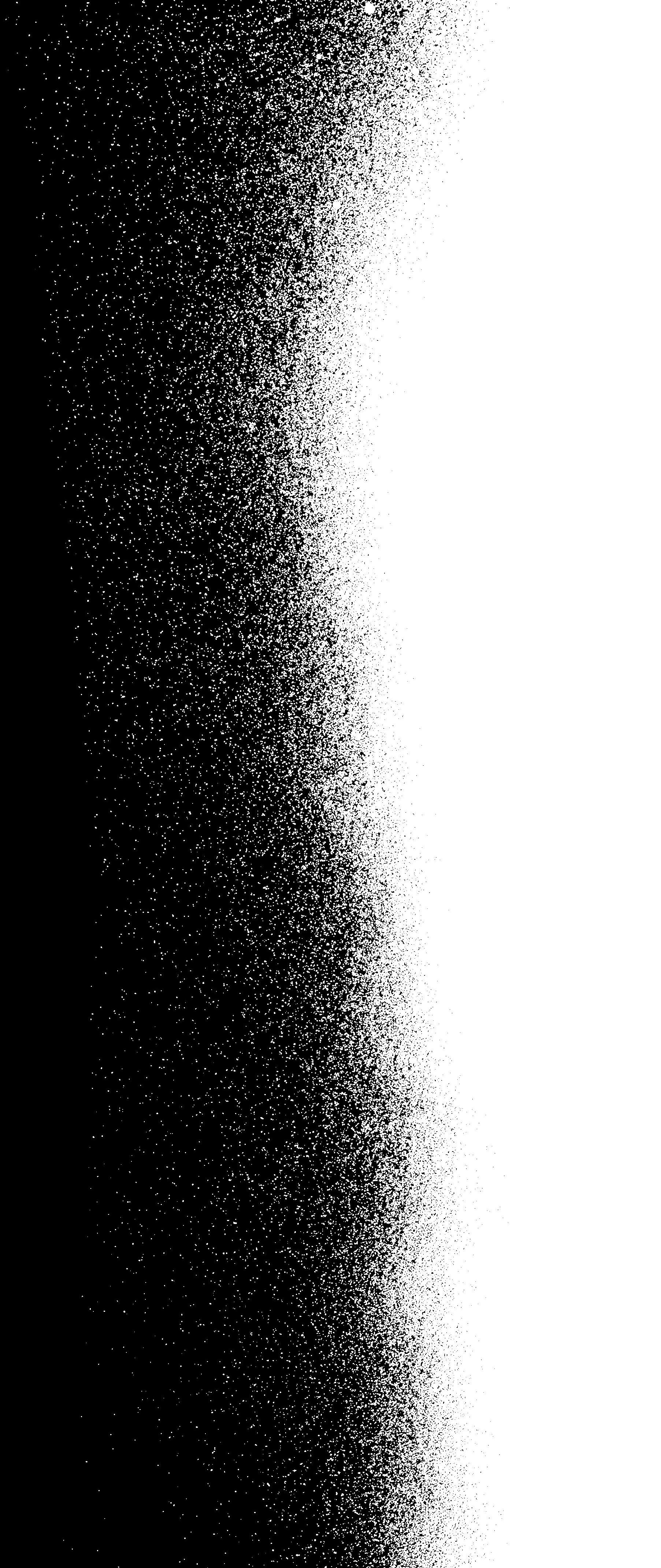
51 | CAM Magazine, Fall 2022
WHAT DOES IT TAKE? WRITTEN BY JULIA MAY
Each academic year, theatre and musical theatre patrons come to Sam Houston State University to be treated to a variety of productions from contemporary to classic and familiar to cutting-edge.
Once the lights go up, the performances typically flow effortlessly from scene to scene with eye-catching costumes and sets, lighting that happens perfectly on cue, and justthe-right sounds to intensify the mood on the stage.
From the time a play is selected until after the final curtain call at the end of the season, faculty, staff, and students are involved in countless hours of decision-making, research, physical labor, discussion, and promotion, all to bring the magic of theatre to audiences. Without this teamwork, the entertaining and sometimes thought-provoking productions most likely would not happen the way they were intended.
“
said Aaron Brown, assistant professor in the Department of Theatre & Musical Theatre. Brown directed the Spring 2022 performance of “Detroit ’67.”

“No matter how brilliant a person on the team may be, if their communication is poor, or if there is animosity and division, it will always affect the outcome,” he said. “That’s not to say that people who do not enjoy being around each other can’t create a good show, but it won’t be as good as it could be.
experience. That way they are not doing all things pre-2000,

“Even if the product is good, the process determines how we feel about it, and that comes across to the audience,” he said. “Even if it doesn’t ruin it, it still affects the audience. We must be able to work with each other, and it’s a great metaphor for how it should be in life. Even with differences of opinions, we are working toward the same goal.”
The process begins before the start of the academic year. The department has recently established a production model that calls for work on performances to begin two years ahead of schedule.

“Each director in the department knows what year they are directing, and we have divided ourselves into different genres to make sure students get a well-rounded experience. That way, they are not doing all things pre-2000, or all things fantasy, or comedy, and so forth,” Brown said.

COLLABORATION IS LITERALLY THE MOST VITAL ELEMENT OF A PRODUCTION”
“I was slated for American Realism for the 2021–22 school year, and I presented two or three titles from that genre to be reviewed by our Season Selection Committee.”
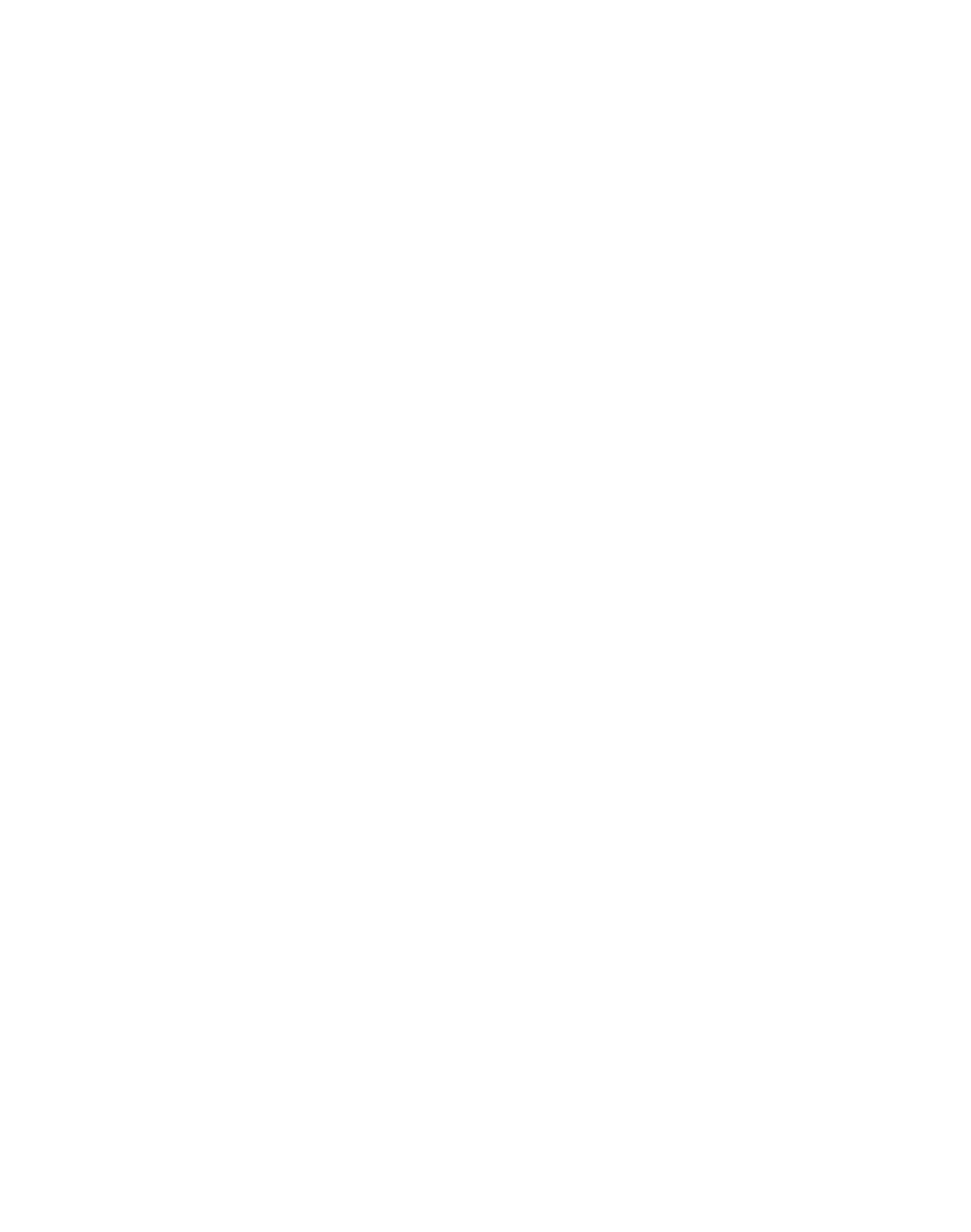


Faculty directors are not the only ones who get to offer their ideas to the committee. Student organizations within the Department of Theatre & Musical Theatre are also encouraged to pitch titles.
“That way, the students get a voice in what we are presenting on stage,” Brown said. The department presents six fully-produced performances in a school year. Four additional student productions take place as part of the “Directors’ Debut Series.” These student-led shows focus more on acting. Costumes and props generally come from what is already in stock so that students can work on their directing skills and communication with actors, as well as the actual acting in their show without the additional burden and responsibility of procuring materials for the show.
The faculty directors submit proposals for their mainstage production to the faculty, explaining why the play is a good fit for students, the university, the community, actors, designers, and the technical crew. The selection committee then meets with each director and narrows the choices down.
“We ask if the play is doable with the resources we have, and if it’s something our technical and costume crews can do within a year,” he said.
When the titles for the season are selected, the faculty announce times for auditions.
Among those reviewing the proposals is Craig Brossman, director of Production and Facilities Operations. Brossman is responsible for the logistics and operation for each production and serves as the liaison with those who are responsible for the scenic design, lights, sound, props, and costumes.
“I get those proposals and I start breaking them down. Every scenic piece has to be developed to be structurally safe within the materials that are available to us, and the materials have to be within the budget,” he said. “Part of my job is to look at the designs and to stay as true to them as possible. However, it might mean making some adjustments. I have to look out for the bottom line.”
Brossman works closely with the directors so that there are no surprises at any time during the process.
“’Detroit ‘67’ is a great example of how smoothly a production can run,” he said. “We had a clear direction from Aaron and knew what his vision was from the beginning.
“Nic Graves, who teaches theatre design and scenic design, served as scenic director. He sent me drafts with enough time for me to review and engineer the design to make sure it was structurally sound and safe, and to be certain that I could obtain the materials needed for the show.”
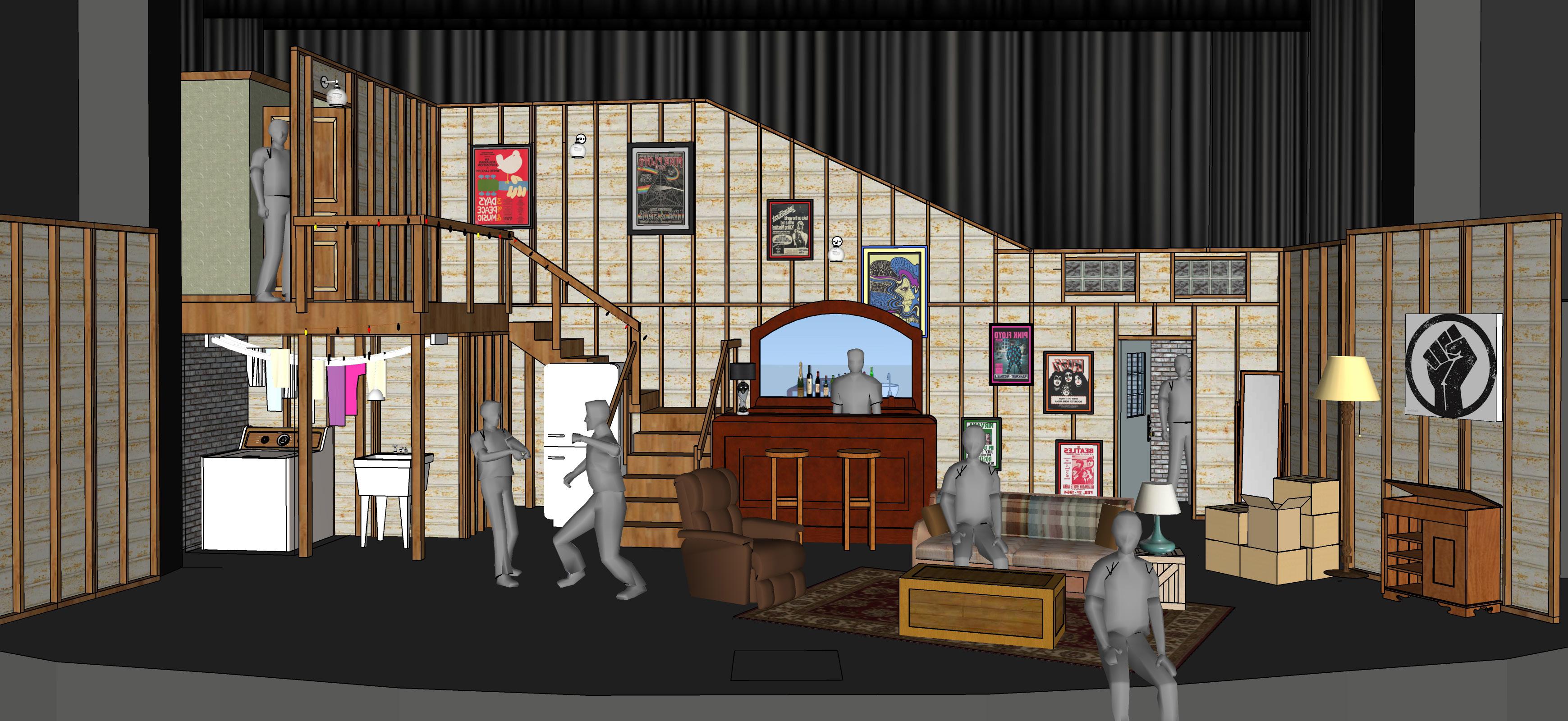
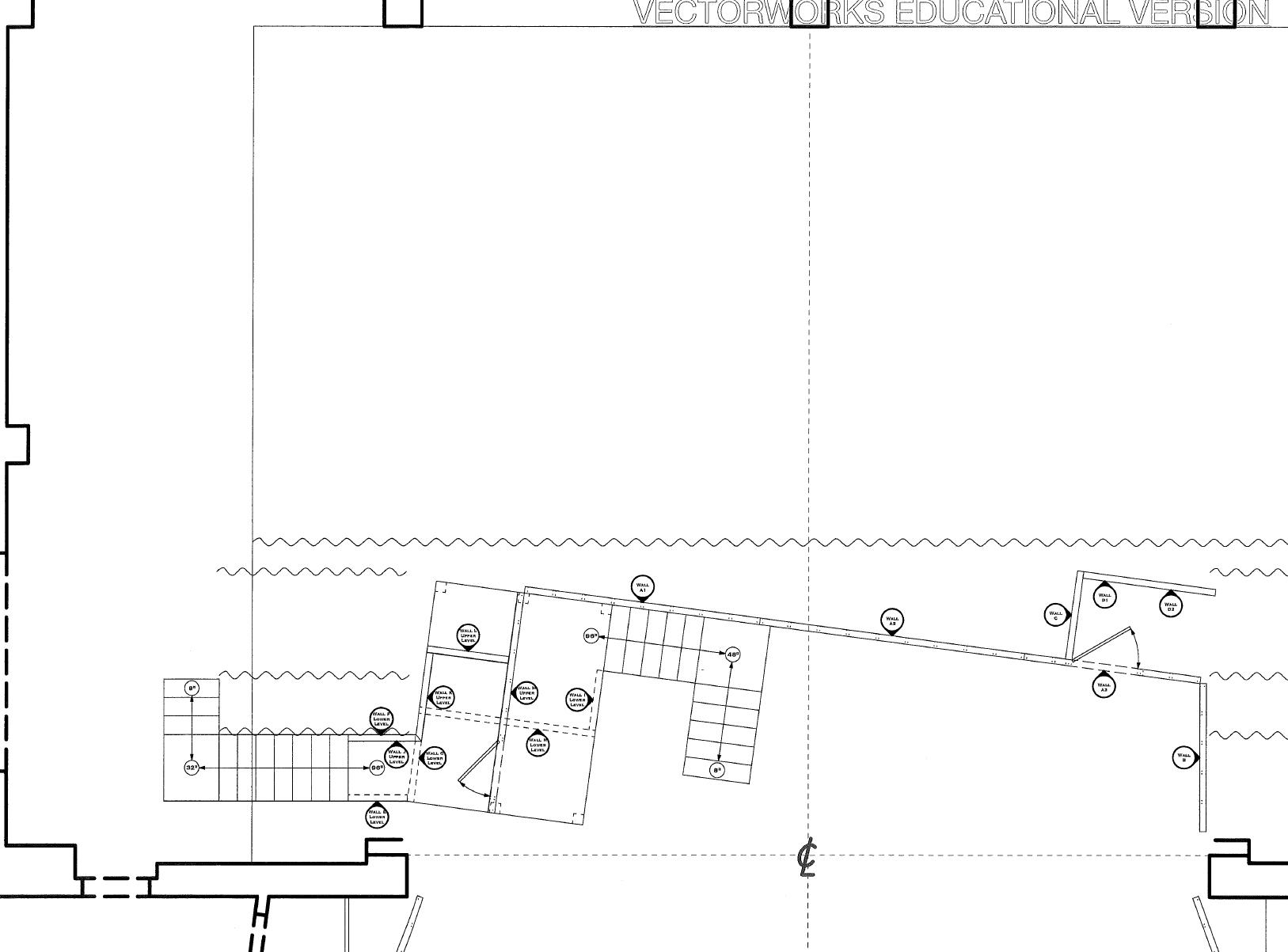
Auditions for “Detroit ‘67” were in November and the cast was selected before the end of the fall semester. Brown met with the students before they left school for winter break.
“I handed out scripts and asked them to come back with their lines memorized so that we could hit the ground running at the beginning of the spring semester,” he said.
With this production, Brown saw an opportunity to enhance the student actors’ experience by having an understudy for each role.
“It was such a small cast and the story focused on an African-American family,” he said. “We don’t often get to tell these stories, so I made the choice — and I was graciously supported by the costume department and our chair — to have an additional person for each part.
“It worked out really well. During the callback auditions, all the students could see the immense talent in the room. I asked the students if they would like to incorporate understudies with a matinee performance for this production, to which they all agreed,” he said.
The main cast was featured in the Thursday, Friday, and Saturday evening performances and the Saturday matinee was chosen to be the understudy performance.
“It was really exciting for the main cast to get to watch the show and see their understudy counterparts perform. It was especially meaningful for the understudies to have their families come in to see them on stage and to celebrate them,” Brown said. “Because they are all unique actors, it was fascinating to see the same story unfold slightly differently from the evening performances to the matinee performance.”
Although rehearsals did not begin until the students returned from winter break, production meetings were taking place long before.
“We have a scenic designer, a lighting/sound designer, and a costume designer,” Brossman said. “We typically have four to six production meetings from start to finish.”
The director shares their vision for the show with the entire team during the first meeting. The designers take that concept and do their own research. In the second meeting, the designers present their work. Costume designers show their renderings of every character and how that character will look. The scenic designer presents the setting description with images from research.
The third meeting is a confirmation of everything that has been discussed previously and a check to make sure everyone is in agreement. At this point, Brossman comes in as technical director and assigns deadlines to the crews. At the fourth meeting, Brossman confirms whether the original plans as they have been presented can be
53 | CAM Magazine, Fall 2022
completed on time. If not, he discusses options.
“It’s always my goal to proceed, but I have to consider that much of the work is done by students, and although the work could be done by the faculty and staff, we rely on the students so that we do not lose the educational component,” he said.
Meetings five and six are for group discussion and solidifying details along with the final schedule. Even after rehearsals begin, conversations continue to take place throughout the process.
“Once we get the show on its feet, we invite all the designers to come watch a designer run of the show, so they have an opportunity to visualize all these ideas that have been presented to them,” Brown said. “The next time we are all together is during tech rehearsals. That’s when we bring everything together and problem-solve and make sure we are good to go.”
Brossman aims for perfection with each project.

“If we’ve done our job right, people actually pay to come see the results of our work, and they will get to enjoy what we have created from practically nothing,” he said. “It’s beautifully satisfying to bring people together and let them escape their reality for a couple of hours in a live performance setting.
“It’s not one person driving the show. From the director to the actors to the stage management team, the lighting crew, the sound crew, the costume crew — we all have something to contribute to the play’s success,” he said. “Sometimes it can take up to 100 people to make a production happen. I’m not saying that we bat 1,000 every single time, but every one of our productions has been with the thought to better our students, the university, and our community.
“We are always trying to learn, which is the reason some of our plays are provocative and push the envelope,” he said. “‘Detroit ’67’ hit home and mirrored events we have recently gone through. History often repeats itself, and we need to be reminded of what happened before and what we can do now to make things better. After all, we are an educational institution and that’s the reason we are here.”


Brown, too, emphasizes the educational component and treats each production like a lab.
“With this story having a largely Black cast, I felt that it was important that the student actors understand the professional model and were prepared to be in a world where they didn’t need to apologize or act as if they were receiving something as a gift,” he said. “I wanted them to work on their confidence in promoting themselves as artists and be able to develop characters for themselves. I am very pleased with the way everything turned out.”
DRIVING THE SOMETHING TO CONTRIBUTE”


55 | CAM Magazine, Fall 2022
A Q&A ON THEATRE PERFORMANCE
WHY IS STUDYING THEATRE VALUABLE?
“Theatre was a safe space for me to express myself and find community, like many other students. Performing is a hard career path, though — you have to be able to take rejection, continuously grow and learn, and there’s no ‘right way’ of becoming a performer. Also, if you choose to become a performer solely for the sake of performing and making yourself feel good, you won’t go very far. Theatre is a live product; it’s collaborative and serves the purpose of shining light on others’ perspectives, emotions, and history. You have to give yourself up for the sake of storytelling. That’s why I find theatre and studying incredibly valuable. It makes you look outside yourself; it develops empathy and compassion. Studying theatre can seem silly at times (and it is — observe any movement or improv class, which are immensely helpful but make you look ridiculous), but the life skills you learn in class are worth the outrageous exercises. You learn how to make connections and find yourself as a performer. You learn what kind of stories you want to tell, how to give and take constructive criticism, and so many ‘whys’ behind what we do.”
WHY DID YOU CHOOSE SHSU?
“When I was initially accepted into the program, I was ecstatic, grateful, and very shocked. It’s terrifying going into a career where you are constantly critiqued and perceived by what you can produce. Sam Houston felt like a safe playing field when it came to figuring out who I was as a performer. I felt able to let myself try and fail, which is so important. The student community here is very welcoming and doesn’t contain a huge ego of ‘I’m better than you because I can belt a high E and do a triple pirouette at the same time.’ Being in-between bigger theatre hubs like Houston and Dallas is encouraging as we have connections and potential professional opportunities, even while we’re in school! Overall, I love the atmosphere and freedom I’ve had to explore as a student, a performer, and as a person here at Sam.”
HOW DO THEATRE STUDENTS WORK TOGETHER AS A TEAM?
“To work together, you have to realize that you are not better than anyone else, and vice versa. You are a team player, all striving for the same goal of creating something impactful and beautiful. For all the plays and musicals at Sam Houston, you find a mix of both tracks in the cast and creative team. Also, both majors (theatre and musical theatre) have very similar core classes like theatre history and play analysis, where we have to work together on group projects and discussion boards. In projects like that, you learn what every person brings to the table, one not being greater than the other.”
HOW IS A TYPICAL DAY IN THEATRE STRUCTURED?
“I am a big morning person. I will always make myself a cup of coffee and eat breakfast, no matter what. If I know it’s going to be a long day, I’ll pack a lunch, too. Most days, I’ll start with a dance class in the mornings, followed by one or two more theatre classes during the day. In between classes, I’ll most likely be lounging in the GPAC lobby, as that’s where most of the theatre students reside going from class to class. Some classes we are required to take include dancing, singing lessons, one acting or directing class every semester, and workshops. Our workshops differ depending on your classification. Underclassmen focus on learning the basics of musical theatre dancing and range from different choreographers to open dance calls, and even partnering this last semester. Upperclassmen go deeper into learning how to work as a team in an ensemble, how to successfully prepare for an audition, and what to be ready for once we graduate. Every day looks different, though! All classes wrap up around 5 pm, and during show seasons, rehearsals will take up most of your nights. If I’m not working in a production, you could find me editing a video, doing homework with other theatre majors, or in the kitchen experimenting or prepping for the week.”
WHAT ARE THE MOST REWARDING AND MOST CHALLENGING ASPECTS OF THEATRE?
“The most rewarding thing is having a rich community that wants you to succeed. When someone wins, we all win. So many of my colleagues and friends are doing great work right now in the summer, and I’m so proud of them. In the same way, many of my friends and colleagues encouraged me and cheered me on during and after the staged reading ‘Ruffled Flourishes’ on campus in May. In that same strain, the most challenging thing for me is comparison — the killer of creativity. I have to constantly remind myself that what specialties I can attribute are valid, and I don’t have to be set side by side with anyone else.”
WHAT ADVICE DO YOU HAVE FOR THOSE CONSIDERING STUDYING THEATRE OR MUSICAL THEATRE?
“Don’t let fear or inexperience stop you! Just because you can’t belt the highest note, don’t have a jam-packed resume, or weren’t nominated for a Tommy Tune or Jimmy Award in high school doesn’t mean your gifts and talents aren’t valued. I didn’t even know what (or who) Tommy Tune was before I got to Sam Houston. If you are hungry to learn and focus on being an open team player, Sam Houston’s your oyster!”
Featuring Cara DeGaish, Musical Theatre Major from Portland, Texas
CAM

SPOTLIGHT
Nikki Kimbrell


 NIKKI KIMBRELL STUDENT THEATRE & MUSICAL THEATRE
Nikki Kimbrell performing as Heather in “Hands on a Hardbody.”
NIKKI KIMBRELL STUDENT THEATRE & MUSICAL THEATRE
Nikki Kimbrell performing as Heather in “Hands on a Hardbody.”
COLLEGE OF ARTS & MEDIA
AUGUST
Art
UNIVERSITY ART COLLECTION
SELECTED WORKS EXHIBITION
August 15 – 27
Reception | August 25 | 6 p.m. University Gallery, HFAB Free Admission
SEPTEMBER
Art
THRESHOLD EXHIBITION
September 6 – October 8
Reception | September 8 | 6 p.m. University Gallery, HFAB Free Admission
Music
SYMPHONIC BAND CONCERT
September 20 | 7:30 p.m.
Payne Concert Hall, GPAC
Music
WIND ENSEMBLE CONCERT
September 22 | 7:30 p.m. Payne Concert Hall, GPAC
Music
SYMPHONY ORCHESTRA CONCERT
September 24 | 7:30 p.m. Payne Concert Hall, GPAC
Theatre & Musical Theatre
AIRNESS
By Chelsea Marcantel
Sept. 29 – Oct. 1 | 7:30 p.m.
October 1 | Matinee | 2 p.m. Showcase Theatre, UTC
OCTOBER
Theatre & Musical Theatre
AIRNESS
By Chelsea Marcantel
Sept. 29 – Oct. 1 | 7:30 p.m. October 1 | Matinee | 2 p.m. Showcase Theatre, UTC
Art
THRESHOLD EXHIBITION



September 6 – October 8
Reception | September 8 | 6 p.m. University Gallery, HFAB Free Admission
Theatre & Musical Theatre
GREEN DAY’S AMERICAN IDIOT Music by Green Day Lyrics by Billie Joe Armstrong Book by Billie Joe Armstrong and Michael Mayer October 13 – 15 | 7:30 p.m. October 15 | Matinee | 2 p.m. Erica Starr Theatre, UTC
Art
63RD ANNUAL FACULTY EXHIBITION
October 16 – November 23
Artists’ Talks | October 20 | 5 p.m. Reception | October 20 | 6 p.m. University Gallery, HFAB Free Admission
Music
JAZZ ENSEMBLE AND JAZZ LAB BANDS CONCERT
October 20 | 7:30 p.m. Payne Concert Hall, GPAC
Dance MASTERS OF DANCE October 20 & 21 | 8 p.m. Dance Theater, GPAC
Music
SOMETHING “OPERA” THIS WAY COMES
October 27 – 29 | 7:30 p.m. Recital Hall, GPAC
NOVEMBER
Art
63RD ANNUAL FACULTY EXHIBITION October 16 – November 23 Artists’ Talks | October 20 | 5 p.m. Reception | October 20 | 6 p.m. University Gallery, HFAB Free Admission
Music
FALL ALL CHOIRS CONCERT
November 1 | 7:30 p.m. Payne Concert Hall, GPAC
Theatre & Musical Theatre AMERICAN SON
By Christopher Demos-Brown November 1 & 3 | 7:30 p.m. November 5 | Matinee | 2 p.m. Showcase Theatre, UTC Theatre & Musical Theatre BETRAYAL
By Harold Pinter November 2, 4, & 5 | 7:30 p.m. Showcase Theatre, UTC Music
SYMPHONY ORCHESTRA CONCERT November 3 | 7:30 p.m. Payne Concert Hall, GPAC Dance SENIOR STUDIO November 3 – 5 | 8 p.m. Dance Theater, GPAC
College of Arts & Media
CAM ARTIST SERIES: HARMONIA STELLARUM HOUSTON, TALES OF ICARUS AND APOLLO Music by Bononcini, Štěpán, and Handel November 5 | 7:30 p.m. Recital Hall, GPAC
Music
WIND ENSEMBLE AND SYMPHONIC BAND CONCERT November 15 | 7:30 p.m. Payne Concert Hall, GPAC
Mass Communication
7TH ANNUAL MASS COMMUNICATION
COMMON READER FILM FESTIVAL
November 16 | 6 p.m. Olson Auditorium, AB IV Free Admission
Theatre & Musical Theatre
ANTIGONE
Freely adapted by Emily Mann from the play by Sophocles
November 17 – 19 | 7:30 p.m. November 19 | Matinee | 2 p.m. Erica Starr Theatre, UTC Music
JAZZ ENSEMBLE AND JAZZ LAB BANDS CONCERT November 22| 7:30 p.m. Payne Concert Hall, GPAC
DECEMBER
College of Arts & Media
CAM ARTIST SERIES: HOLIDAY CONCERT
December 1 & 2 | 7:30 p.m. Payne Concert Hall, GPAC
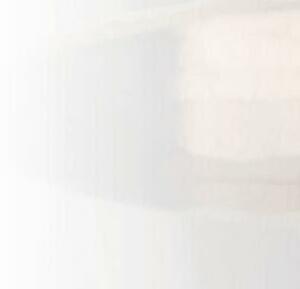
Dance DANCE SPECTRUM IN CONCERT December 1 – 3 | 8 p.m. Dance Theater, GPAC
Art
STUDIO ART, PHOTOGRAPHY, AND ANIMATION SENIOR EXHIBITION December 5 – 10 Reception following commencement ceremony University Gallery, HFAB Free Admission
59 | CAM Magazine, Fall 2022
2022 - 2023 SEASON
ART DANCE MASS COMMUNICATION MUSIC THEATRE & MUSICAL THEATRE
JANUARY
Art
SCARCITY AND ABUNDANCE
EXHIBITION
January 26 – March 4
Reception | January 26 | 6 p.m. University Gallery, HFAB Free Admission
FEBRUARY
Art
SCARCITY AND ABUNDANCE EXHIBITION
January 26 – March 4 Reception | January 26 | 6 p.m. University Gallery, HFAB Free Admission
Theatre & Musical Theatre
FADE
By Tanya Saracho
February 14 & 16 | 7:30 p.m. February 18 | Matinee | 2 p.m. Showcase Theatre, UTC
Theatre & Musical Theatre
THIS IS OUR YOUTH
By Kenneth Lonergan
February 15, 17, & 18 | 7:30 p.m. Showcase Theatre, UTC
Music
SYMPHONY ORCHESTRA CONCERT
February 18 | 7:30 p.m. Payne Concert Hall, GPAC
Music
WIND ENSEMBLE CONCERT
February 23 | 7:30 p.m. Payne Concert Hall, GPAC
Art
SCARCITY AND ABUNDANCE EXHIBITION
January 26 – March 4
Reception | January 26 | 6 p.m. University Gallery, HFAB Free Admission
Music
CONCERT AND SYMPHONIC BAND CONCERT
March 2 | 7:30 p.m.
Payne Concert Hall, GPAC
College of Arts & Media
CAM ARTIST SERIES: TEXAS GUITAR QUARTET March 3 | 7:30 p.m. Recital Hall, GPAC
Music
CHORALE SPRING CONCERT WITH SHSU ORCHESTRA March 4 | 7:30 p.m.
Payne Concert Hall, GPAC
Music
JAZZ ENSEMBLE AND JAZZ LAB BANDS CONCERT March 9 | 7:30 p.m.
Payne Concert Hall, GPAC
Music
SHSU OPERA PRESENTS: TWENTY FOUR, OR THE CURE FOR LOVE March 23 – 25 | 7:30 p.m.
Payne Concert Hall, GPAC
Art
23RD ANNUAL JURIED STUDENT EXHIBITION March 27 – April 6
Reception & Awards | March 30 | 5 p.m.
University Gallery, HFAB Free Admission
Music BELLES VOIX AND MUSIKANTEN CONCERT
March 28 | 7:30 p.m.
Payne Concert Hall, GPAC
Theatre & Musical Theatre
365 DAYS/365 PLAYS (FULL-LENGTH)
By Suzan-Lori Parks March 28 – April 1| 7:30 p.m.
April 1| Matinee | 2 p.m.
April 3 & 4 | 7:30 p.m.
Showcase Theatre, UTC
Music
SHSU BILL WATROUS JAZZ FESTIVAL
March 31 & April 1| 7:30 p.m. Concert Hall, GPAC
Music WIND ENSEMBLE CONCERT April 20 | 7:30 p.m.
Payne Concert Hall, GPAC
College of Arts & Media
CAM ARTIST SERIES: DIEGO & FRIENDS FT. CARPE DIEM STRING QUARTET April 24 | 7:30 p.m. Recital Hall, GPAC
Music
CONCERT AND SYMPHONIC BAND CONCERT April 27 | 7:30 p.m.
Payne Concert Hall, GPAC
Theatre & Musical Theatre SWEENEY TODD
Music & Lyrics by Stephen Sondheim Book by Hugh Wheeler
From an Adaptation by Christopher Bond
Theatre & Musical Theatre
365 DAYS/365 PLAYS (FULL-LENGTH)
By Suzan-Lori Parks
MARCH APRIL MAY
March 28 – April 1| 7:30 p.m. April 1| Matinee | 2 p.m. April 3 & 4 | 7:30 p.m. Showcase Theatre, UTC
Music
SHSU BILL WATROUS JAZZ FESTIVAL March 31 & April 1| 7:30 p.m. Payne Concert Hall, GPAC
Art
23RD ANNUAL JURIED STUDENT EXHIBITION March 27 – April 6

Reception & Awards | March 30 | 5 p.m. University Gallery, HFAB Free Admission
Dance
SENIOR STUDIO April 13 – 15 | 8 p.m. Dance Theater, GPAC
Art
GRAPHIC DESIGN SENIOR EXHIBITION April 17 – 29
Reception & Awards | April 20 | 5 p.m. University Gallery, HFAB Free Admission
Music JAZZ ENSEMBLE AND JAZZ LAB BAND CONCERT May 2 | 7:30 p.m. Payne Concert Hall, GPAC
Dance DANCE SPECTRUM IN CONCERT May 4 – 6 | 8 p.m. Dance Theater, GPAC
Music

MASTERWORKS CONCERT FT. SYMPHONY ORCHESTRA AND SHSU CHOIRS May 4 | 7:30 p.m.
Payne Concert Hall, GPAC
Art
STUDIO ART, PHOTOGRAPHY, AND ANIMATION SENIOR EXHIBITION May 8 – 13
Reception following commencement ceremony University Gallery, HFAB Free Admission

TO OUR DONORS
January through Decemeber 2021 donoros listed below.
Because of the incredible generosity of our donors, the College of Arts & Media is able to provide exceptional opportunities that prepare and educate students for professional success and keep academic units within the College at the forefront of innovation through scholarships, an inspirational and talented faculty, and beautiful state-of-the-art facilities. The faculty, staff, and students are deeply grateful for the support we receive from our benefactors and the partnership we have with each individual. “Thank You” to the following for your contributions.
Dr. I. Robert Adams and Dr. Helena Halmari Adams
Mr. and Mrs. Randal L. Adams
Mrs. Jill Adams
Mrs. Sheila B. Alexander
Mr. Prince R. Alfaro
Mr. and Mrs. Michael D. Allen
Mr. Thomas A. Allen
Ms. Jane A. Alvizo
Ms. Monica J. Anderson Mrs. Brenda F. Anderson Rees
Ms. Darlene K. Andrews
Dr. William L. Angrove and Dr. Kay E. Angrove Ms. Marissa Anthony
Mr. Christopher A. Arcos
Ms. Jamie D. Arlt
Mr. Herb P. Armstrong
Ms. Martha J. Arnold
Mrs. Holly D. Arnold
Mr. and Mrs. William L. Atkins
Mr. Kenneth Avery and Dr. Laura S. Avery
Mr. and Mrs. Adam D. Babcock
Ms. Kaela A. Babin
Mr. John C. Baker III
Mr. and Mrs. William R. Baldwin
Mrs. Martha A. Balusek
Ms. Diana K. Barnes
Mr. William A. Bartlett
Ms. Mary E. Basham
Mr. Tim Batchelor
Mr. and Mrs. James R. Bates II
Ms. B. Jean Bawden
Ms. Rhonda V. Beassie
Mr. Robert C. Benitez
Ms. Courtney Benjamin
Ms. Kaye Bennett
Mr. Wayne Bennett
Mr. Lance A. Bielz
Mr. and Mrs. Stephen M. Blank
Mr. and Mrs. Gregory A. Blase
Ms. Coralie Blount
Mr. Jacob J. Bonilla
Mr. Steven L. Boone
Ms. M. Kate Borcherding
Dr. Tony Boutte
Ms. Ynette A. Boyce
Mr. and Mrs. T. Brian Boyd
Mr. and Mrs. D. Bruce Boyd
Mr. and Mrs. Craig T. Brossman
Mr. Aaron M. Brown
Mrs. Stephanie Burke
Mr. Samuel R. Burnes
Dr. and Mrs. Rodney M. Cannon
Mr. and Mrs. Michael Capps
Mr. Scott Card and Dr. Patricia P. Card
Dr. Macaela M. Carder
Ms. Patricia A. Cargill Mr. Tongfang Chen Ms. Natalie A. Cherry Mrs. Ellen R. Christie Ms. Mary N. Church Mr. and Mrs. Joseph R. Clark Dr. Kevin M. Clifton Mr. and Mrs. Bryan L. Collier Dr. and Mrs. Robert E. Coons, Sr. Ms. Carol A. Cooper Mr. Alex W. Copeland
Mr. A. J. Cortez and Mrs. Julie A. Stone Cortez Mr. and Mrs. Eric T. Crabtree Ms. Alison E. Craig
Mr. Kevin G. Crouch Mr. and Mrs. John Crystal, Jr. Dr. and Mrs. Paul M. Culp, Jr. Mr. Michael J. Czerwinski Mr. and Mrs. Alan A. Dahlberg Mr. and Mrs. Christopher T. Daniel Dr. and Mrs. Robert N. Daniel Mrs. Donna S. Davis Mr. and Mrs. Michael R. Davis Ms. Krystal M. Davis Mrs. Lynda C. Dawson Mr. and Mrs. Servando De Leon Ms. Mary J. Deaver Mr. and Mrs. Henry W. Dedek Mr. and Mrs. David J. Deveau Mr. Barry Doss Ms. Catherine E. Duhon Mr. and Mrs. James Dunham Mr. and Mrs. Bryan Duran Mr. and Mrs. Daniel W. Eaton Dr. Richard F. Eglsaer Mr. and Mrs. Charles E. Ellis Mr. Darius L. Estell Mrs. Eleanor Evans Mr. and Mrs. Jack L. Fields Mrs. Rebecca L. Finley Mr. and Mrs. Larry D. Finley Mr. and Mrs. Dean R. Fishburn Mr. John B. Foerster Mr. and Mrs. Daniel R. Foster Mr. and Mrs. Michael D. Foster Ms. Nancy W. Franklin Mr. and Mrs. Howard L. Free Dr. and Mrs. Donald G. Freeman Mr. and Mrs. Paul R. Freese Dr. and Mrs. Charles M. Friel Ms. Dorothy L. Fulton Dr. Marcus J. Funk Mr. Thomas W. Fusselman, Jr.
Mr. and Mrs. John D. Garvin Dr. Brian Gibbs
Mr. and Mrs. William P. Gillette Mrs. Glenda L. Goehrs
Mr. and Mrs. Marvin E. Gorley Ms. Weslie R. Gray Ms. Sharla S. Grayson
Mr. and Mrs. Michael W. Greeney Mr. Eric L. Grimes and Dr. Rebecca L. Renfro Dr. and Mr. Dana R. Guidroz Mr. Bruce D. Hall Mrs. Kristina S. Hanssen
Mr. and Mrs. Doyle R. Happe Mr. and Mrs. Aaron C. Harbaugh Ms. Autumn R. Harms
Ms. Kashaundra M. Harris Ms. Cynthia H. Harris Ms. Claire L. Hart-Palumbo Ms. Penelope A. Hasekoester Mr. and Mrs. Dave C. Hassler Ms. Deborah A. Hatton Ms. Shannon G. Heath Ms. Heidie M. Hegman Dr. Emily H. Heilman Mr. and Mrs. Jack L. Helmcamp Mr. Michael H. Henderson Mr. and Mrs. Keith Hermes Ms. Elisa Herrman

Mr. and Mrs. Craig Hibbison Dr. and Mrs. Tom D. Hill Ms. Malin S. Hilmersson Dr. Gary A. Hilsher
Mr. and Mrs. Gregory F. Hinze Mr. and Mrs. Lloyd Hisaka Mr. and Mrs. Robert M. Hodge Mr. Frank R. Holmes and Dr. Maria A. Holmes Mrs. Sandra S. Huffman Mr. Marcus J. Hughes Mr. Harold A. Hurry Dr. Robin D. Jackson Ms. Mary K. Jackson Dr. and Mrs. Keith E. Jenkins Ms. Aundrea L. Johnson Mr. and Mrs. Charles W. Jones III Mr. and Mrs. Randal E. Jones Mr. and Mrs. Murphy Jordan Dr. Barbara A. Kaminska Mr. and Mrs. Myron S. Karner Mr. and Mrs. Samuel K. Keen Mr. and Mrs. James E. Keith Dr. Peter K. Kempter and Dr. Peggy A. DeMers Ms. Kathy G. Kernek Mrs. Britney R. Ketkoski Ms. Taehee Kim
61 | CAM Magazine, Fall 2022
Ms. Dianna Kim
Mr. and Mrs. Jacob B. King
Ms. Iva Kinnaird
Mr. Christopher S. Kopech
Dr. Richard O. Kosuowei
Mr. and Mrs. Kenneth W. Krock
Dr. Lana Kuscer
Dr. Marvin L. Lamb
Dr. and Mrs. Robert A. Lane
Mr. and Mrs. Matt LaSalvia
Mr. and Mrs. Chris Lee
Ms. Rebecca J. Lewis
Mr. Richard J. Lindley, Jr.
Ms. Lacey L. Little
Mr. and Mrs. Robert J. Littlefield
Ms. Kristin Lucas
Mrs. Mary A. Lynch
Mrs. Linda L. Macdonald
Mrs. Nancy A. MacKinnon
Mr. John Maisel
Ms. Cecelia P. Marquart
Mr. Derek L. Martin
Ms. Derika R. Maxwell
Mr. Seth T. McAdow
Mr. and Mrs. Paul A. McBeth Ms. Darla McBryde
Mrs. Marian B. McDonald
Mr. and Mrs. Donald McGinty Dr. and Mrs. Matthew McInturf Mr. Cleavy McKnight
Mr. and Mrs. James T. McLaughlin Mr. and Mrs. John L. McSpadden
Mr. Kenneth D. Meador
Dr. and Mrs. Stephen H. Means
Dr. Melissa L. Mednicov
Ms. Maira Mejia
Mr. and Mrs. Jose M. Mendez
Mr. and Mrs. Matt R. Menefee
Mrs. Mary M. Migliozzi-Chambers
Dr. and Mrs. Brian Miller
Mr. Carson S. Miller
Ms. Lupita M. Mirafuentes
Ms. Carolyn E. Miterko
Ms. Alicia J. Moore
Dr. Carolyn D. Moore
Dr. Donald A. Morgan
Dr. Edward M. Morin and Mrs. Patricia K. Ramsay
Mr. and Mrs. Scott Moseley
Mr. and Mrs. Charles R. Moser
Mr. and Mrs. William C. Mullins
Mr. and Mrs. Steven Mullis
Mr. and Mrs. Benjamin D. Murdock
Mr. and Mrs. Andrew M. Noble Dr. Ronald B. O’Neal II
Mrs. Jamie K. Orozco
Mr. C. Kelley Osborn
Mr. and Mrs. R. Ben Osborne Ms. Rebecca I. Oswald Mrs. Crystal R. Ovalle Mrs. Lisa C. Owen
Mr. Matthew J. Owens Ms. Olivia Pardue Mrs. Gradylene J. Pate Mrs. Grettle O. Payne Mr. Glenn M. Payne
Mr. and Mrs. James Payne Mr. Patrick N. Pearson Dr. and Mrs. Ralph W. Pease
Mr. and Mrs. Bennett L. Perkins
Mr. and Mrs. Joseph E. Peters Mrs. Ellen P. Happe Phillips and Mr. Terry Phillips Mr. Dennis L. Phipps
Dr. Javier A. Pinell and Dr. Naomi K. Gjevre Dr. Scott D. Plugge Dr. and Mrs. Thomas C. Prior Mr. Jacob J. Puente Dr. and Mrs. N. Ross Quarles Ms. Debra A. Rawlins Ms. Alisa Reed Mrs. Brenda F. Anderson Rees Mr. and Mrs. Robb R. Reeves Mr. and Mrs. James C. Renfro, Jr. Ms. Abbie L. Respondek Mr. and Mrs. Juan Reyes Ms. Lynn C. Reynolds Mr. and Mrs. Stephen E. Richardson Mr. and Mrs. William Riddell Mr. Jose M. Rivera Mr. and Mrs. Cory S. Roberts Mr. and Mrs. M. Shane Rogers Mr. Richard A. Rodriguez Ms. Jen D. Rodriguez Mr. and Mrs. Richard S. Rose Mr. Allen Ruiz Mr. and Mrs. Doug Rutledge Mrs. Roberta C. Sage Mr. and Mrs. Joel L. Salmons Dr. and Mrs. E. Wesley Sanders Mr. and Mrs. James R. Satterfield Mrs. Dorothy Schaettle Dr. Aric L. Schneller Mr. and Mrs. Jim Sessions Mr. and Mrs. W. Doug Shaw Mr. and Mrs. Melvin Sherrouse Mr. Tony R. Shipp Mr. and Mrs. Thomas E. Skains Dr. and Mrs. Gerald D. Skidmore Mr. and Mrs. Jeff Slepak
Ms. Santana K. Smith
Mr. Matthew Smith
Mr. and Mrs. Waco Smith
Mr. and Mrs. John W. Smith
Dr. B. Carol Smith
Ms. Zoe Sommers
Mr. Garrett M. Sorem
Dr. and Mrs. Victor E. Sower Mrs. Christy Starr
Mr. Matthew J. Stepan
Mr. and Mrs. Dean F. Stepke
Mr. and Mrs. Dennis Stoker
Mr. and Mrs. Barry G. Stubbs
Dr. Masahito Sugihara
Ms. Jacqueline P. Swan
Ms. Amber L. Tatum
Mr. Joshua A. Taylor
Dr. Kayoko D. Temple
Mr. and Mrs. Adam W. Thibodeaux
Mr. and Mrs. Kenneth A. Thompson
Mr. William H. Tone
Mr. and Mrs. John L. Trotter
Ms. Carolyn Tucker
Mr. Stephen M. Van Hooser
Mr. and Mrs. Keith Y. Walshak
Dr. and Mrs. Richard E. Watts, Ph.D. Mr. Charles L. Way Mr. Robert S. Wehmeyer
Mr. John F. Weimar and Dr. Holly A. Weimar Dr. Robert M. Maninger and Mrs. Edith C. Wells Ms. C. Lynne Werner
Mr. and Mrs. Cliff M. West, Jr. Mr. and Mrs. Bernard West Mr. Clay D. West
Ms. Helen E. Whigham
Dr. Grant Wiedenfeld
Mr. and Mrs. Steven Wiggs
Mr. and Mrs. Jessie Wilder Dr. Linda J. Wiley
Mr. and Mrs. Walter A. Wilkerson
Mr. and Mrs. Michael F. Williams Mr. Howard S. Williams, Jr.
Mr. and Mrs. Mark Wilson
Mr. and Mrs. Sean C. Winn
Mr. Garrett E. Withers
Mr. Lorenc Wojciech

Mr. and Mrs. Tommy Wood
Mr. and Mrs. David L. Worthington
Mr. and Mrs. Christopher K. Wyrick
Ms. Mercedes R. Yanes
Mrs. Nellie J. Yarotsky
Mr. Christopher R. Young
Mr. Adrian C. Zavala
CLICK HERE TO BECOME A DONOR OR RENEW YOUR SUPPORT
College of Arts & Media Office of the Dean Box 2393, Huntsville, TX 77340-2393

BECOME A CAM DONOR
 4th Edition College of Arts & Media Magazine, Fall 2022
4th Edition College of Arts & Media Magazine, Fall 2022

















 submerged the audience into diverse creations ranging from cultural dance works to picturesque storytelling, to going against societal normality through works created by 15 dance artists of our 2022 senior class.
The Bill Watrous Jazz Festival made its comeback in April and included an exciting reunion performance by the 1978 SHSU “Catabiando!” Jazz Ensemble conducted by David Caffey. ��
always a bittersweet day in the studio when our student crews wrap up their last newscast of the semester.
from a 1997 documentary by S.R. Bindler, “Hands on a Hardbody” shared the story of a hard-pressed bunch of Texans hoping to beat the odds and win a truck in a grueling contest, fighting to hold onto hope in the face of fierce economic headwinds and bad breaks.
written by Jackie Swan
submerged the audience into diverse creations ranging from cultural dance works to picturesque storytelling, to going against societal normality through works created by 15 dance artists of our 2022 senior class.
The Bill Watrous Jazz Festival made its comeback in April and included an exciting reunion performance by the 1978 SHSU “Catabiando!” Jazz Ensemble conducted by David Caffey. ��
always a bittersweet day in the studio when our student crews wrap up their last newscast of the semester.
from a 1997 documentary by S.R. Bindler, “Hands on a Hardbody” shared the story of a hard-pressed bunch of Texans hoping to beat the odds and win a truck in a grueling contest, fighting to hold onto hope in the face of fierce economic headwinds and bad breaks.
written by Jackie Swan







































 PATRICK RICHARDS MFA CANDIDATE ART & SOCIAL PRACTICE
From left: Glenda Denton, Magdalena Mendoza, Marcelle Cavazos, and Patrick Richards
PATRICK RICHARDS MFA CANDIDATE ART & SOCIAL PRACTICE
From left: Glenda Denton, Magdalena Mendoza, Marcelle Cavazos, and Patrick Richards








 MADELYN KLUMB
MFA CANDIDATE DANCE
“Textured Walls (The Walls Are a Beach)” by Madelyn Klumb in collaboration with pictured dancer, Sophia Green.
MADELYN KLUMB
MFA CANDIDATE DANCE
“Textured Walls (The Walls Are a Beach)” by Madelyn Klumb in collaboration with pictured dancer, Sophia Green.









 COBY LOBAUGH CREATOR LONE STAR STORIES
Coby Lobaugh interviewing Cherelle “Torch” George #10. Photo by Grace Cambell.
COBY LOBAUGH CREATOR LONE STAR STORIES
Coby Lobaugh interviewing Cherelle “Torch” George #10. Photo by Grace Cambell.

 by Julia May
by Julia May
































